Heavy Tanks
Medium Tanks
Light Tanks
Armored Personnel Carriers
Other Vehicles
Heavy Tank Prototypes & Projects
- IS-7 (Object 260)
- K-91 (Front-Mounted Turret)
- K-91 (Rear-Mounted Turret)
- Object 257
- Object 705 (Tank-705)
- Object 718
Other Prototypes & Projects
- 1K17 Szhatie
- 7.5 cm SPG (Soviet Hetzer Starr)
- Gremyakin’s Medium Tank (STG)
- K-91 SPG
- Object 416 (SU-100M)
- Object 704
- Object 715
- Object 911
- Object 911B
Fake Tanks
Soviet Vehicles in Foreign Service
- 4K51 Rubezh in Romanian Service
- Baterija Raketa Obala-More “BROM” (4K51 Rubezh in Yugoslav Service)
- BMP-1A1 Ost and BMP-1 in Reunified German Service
- GT-MU Fire Support Vehicle
- Pansarbandvagn 501
- PT-76 in Malian Service
- PT-76B in Yugoslav Service
- T-54B in Malian Service
- T-62 in Algerian Service and T-62-Berezhok Conversion
- T-72 Ural-1 in Romanian Service
- ZSU-57-2 in Yugoslav Service
Situation in 1945
In 1945, the Red army seemed unstoppable. With almost twice the numbers of soldiers and armored vehicles than the Allies, some of the top staff officers realized how easy it could have been to not stop half way but just run to the sea with such a massive and well-oiled war machine, fulfilling the promised “world proletarian revolution” prophesized by Lenin. Both sides were indeed well aware of what was seen largely as an uneasy alliance, dictated by circumstances, and after the end of hostilities, peace negotiations with Stalin proved to be especially tough.
The West did not saw the political turn of events in eastern Europe in a favorable way, so much so that tensions rose almost immediately for the control of Berlin and partition of Germany according to the respective advance of the parties.
The Red Army fielded an impressive array of tanks, perhaps 50,000 surviving T-34s of all types and several thousands of IS-1, 2, 3, among other armored vehicles that were partly sent back from Mandchuria.
At that point in early 1946, a fight would have been a long and protracted one, since on both sides soldiers and crews were well equipped quite experienced. In a “what-if” scenario, the 1944 Sherman had serious capabilities against the T-34/85, with guns and targeting sights that would have compensated for a dire numeric inferiority. On paper, the IS-3 seemed superior to the M26 Pershing, but the latter had a far greater rate of fire and probably better range and reliability.
In addition most of the light tanks (T-50, T-60 & T-70s) fielded by the Red army were quite inferior to the M24 Chaffee. In addition there was still no doctrine associated with infantry carried by armoured vehicles, contrary to the US Army which actively tested fully enclosed tracked APCs.
The turn of 1947
Several events consolidated the partition of Germany and mutual defiance emerged in 1946-47 that are related to the fall of the “Iron curtain” according to the legendary “Sinews of Peace” speech of Winston Churchill on 5 March 1946, at Westminster College. At that point the tension just rose to the point of no return. The creation of the Cominform appeared to tightening up the grip on the new East European territories by Moskow, but the Tito-Stalin split proved that this control was not destined to be absolute.
Since early 1946, Washington was warned and encouraged to take a had line against USSR (George F. Kennan’s “Long Telegram”) and Truman’s advisors seemed to confirm this position afterwards, building the containment doctrine which later evolved to the 1950s “domino effect” containment theory that conducted US forces in Korea and Vietnam. The situation was rendered even worse on the soviet side, when the Molotov co-signed the Novikov telegram sent to the US embassy.
There was a mood of “capitalistic conspiracy” and mutual defiance in the east, well fed by an increasingly paranoid Stalin, which could led to a new conflict for many officers. The Morgenthau Plan -a proposition for rearming Germany- added further provocation to this already tense situation. The plan was postponed until 1954, resulting in the creation of two rival military organizations.
The Korean war (1950-53)
The first “hot” conflict to emerge in this tense environment saw Korea involved in a four-year indirect confrontation between the two superpowers and their own spheres of influence. Despite being fought in a single country, it drew nations from all over the world. It was trigerred by an invasion by North Korean forces, and the UNO response, which led a coalition of nations led by the U.S. to help defend South Korea. The North Korean forces were then largely supplied by Stalin in relatively modern tanks, trucks, artillery, and small arms. Tanks were of world war two stock, the bulk being T-34/85s.
At first, the military confrontation in the southern plains saw an ideal terrain for tanks in both camps, many US tanks being then also of ww2 stock. The first military aid given to South Korean forces were M24 Chaffee, easily matched by the T-34s.
Things changed however with massive US reinforcements and the landing at Inchon, the situation was reversed and better allied tanks were fielded, the M26 Pershing and M46 Patton, and for the first time, the British Centurion, that ruled supreme, washing over any opposition. After the conflict was displaced due north in mountainous terrain, tanks to tanks encounters became the exception. When Chinese Forces massively intervened to avoid the collapse of a friendly army, their own tanks were also soviet-supplied and mostly used for infantry support.
The Korean war served as a testing ground for soviet pilots, but there is no record of soviet tank crews being engaged in active military operations, other than a few advisors. No T-54, then a new and formidable generation of tanks, ever saw action in this conflict, despite an assumed superiority over allied tanks. But reports of the rare tank to tank battles of the conflict were carefully studied by soviet military intelligence and lessons passed onto soviet tanks design in the late 1950s, as well as those learned later from the Franco-British-Israeli intervention against Egypt (then also equipped with ww2-era soviet armour) over the Suez canal.
The Warsaw pact (1955)
The German Democratic Republic, the People’s Republic of Bulgaria, of Poland, of Romania, of Hungary, of Albania and the Czechoslovak Socialist Republic constituted the foundations of the future Warsaw pact, in a later response to NATO, formed in April 1949. This further institutionalized the cold war, following the refusal of the Marshall plan and the constitution of an Eastern equivalent, the Molotov plan. The Warsaw pact really began as a military side of the Council for Mutual Economic Assistance (CoMEcon) in 1955 after West Germany was officially integrated inside NATO.
According to this military alliance, all the eastern European states would receive not only a whole array of modern weapons, but also participate with their industrial capabilities (this was especially true for Poland and Czechoslovakia) to the building of a formidable conventional force. The Warsaw pact became synonymous to the ever growing ever-threatening shadow of tens of thousands of tanks and armoured vehicles that will drive NATO’s experts and military policy, in the Pentagon and at the general staffs in all Western countries, and had a tremendous influence on tank design. Despite its notorious independence, Yugoslavia also imported soviet armoured vehicles and began to develop its own variants and derivatives in the 1980s.
Situation in 1960
At that time, the Red Army had completely modernized its conventional forces both in air and land, built a massive nuclear deterrent and a formidable naval force altogether. Despite the death of Stalin, there were still hard-liners in the supreme soviet council that believed war was inevitable. One of these hard-liners, Nikita Khrushchev was in power at that time. In 1960 the bulk of soviet armour was still made of large fleets of T-34/85s, reinforced by ten of thousands of T-54s, and a few thousands of the new T-55s. For the first time, soviet troops had a large array of specialized vehicles at their disposal, the BTRs (Bronetransporters) all wheeled (4×4 – the BTR-40, 6×6 – the BTR-152, and 8×8, the brand new BTR-60) at the exception of the amphibious and tracked BTR-50s. This early generation of vehicles had open troop compartments contrary to US practice. This reflected the ww2 inherited practice of quick deployment that saw infantry disembarking by jumping over the side. But since 1958, the threat of shrapnels and later NBC weaponry conducted the soviet industry to have all these vehicles covered in a proper way.
The soviet doctrine, despite the lessons learned from failed or near-failed airborne operations, like the German assault on Crete, and “Market Garden” still had a tremendous respect for the paratroopers capability, inherited from the old 1930s “deep battle” tactical doctrine. Large paratroopers units were maintained, and equipped with a variety of support vehicles, like the ASU-57 tankettes and later ASU-85 SPGs or the 1970s BMD-1 infantry fighting vehicle. These vehicles were airdropped with several systems, some using rocket-launched platforms. All three tanks could be also airlifted and landed on any spot on the map thanks to the help of massive helicopters like the Mil MI-6 (1957). American equivalents like the M41 Walker Bulldog and the M551 Sheridan were less successful in this way.
A third component was the soviet Marines, well equipped since a true amphibious force was set-up for worldwide interventions. The quest for amphibious or water-fording capable vehicles concerned most if not all armoured vehicles in the soviet inventory that were first conceived in the late 1950s. Both the PT-76 and the BTR-50 which was based on the same chassis, shared excellent amphibious capabilities that were well-studied contrary to regular medium tanks that need a lot of preparations to ford rivers, being submerged. Floating vehicles were not a new concept for the red army.
It goes in straight line to the 1930s T-37A and T-38 tankettes inspired by a 1930 Vickers prototype, but production and development was put to a halt due to wartime priorities, and production restricted to a very few selected models. However there was no real equivalent in the red army to the American array of LVTs before the 1960s.
The late 1970s challenges
(Section in writing)
The Afghan war (1982-89)
(Section in writing)
The fall of USSR and fate of the Army
(Section in writing)
Heavy tanks, from the IS-3 to the T-10 (1959)
IS-3 (1945)

2311 built. Developed from 1944 but only introduced at the very end of the war this third gen. heavy tank called “Spike” and introducing the new hemispheric cast turret has a completely revised armor but the same 122mm gun as for the IS-2, and served until the 1960s.
IS-4 (1947)

250 built. The IS-4 was a less ambitious design, an alternative to the IS-3. The hull was still inspired by the T-34 simple design (although with a faceted front) and the turret was modeled after the T-34/85 one. Production was stopped because of poor mobility and its short active service was spent facing China.
IS-6 and IS-7 (1945 and 1946)

The IS-6 prototype Object 253 tested an electrical transmission, but the project was dropped as it was prone to overheating. The Object 252 had the same design but with a modified drivetrain and conventional transmission. The IS-7 (3 prototypes) was developed in 1948 with a 130 mm S-70 gun and autoloader in a hemispheric turret. At 68 tons it was the heaviest of the serie. The driver was hydraulically assisted, and it had a brand new 1050-horsepower engine under his feets capable to bring this tank to 60 km/h. The armor was proof against 130mm rounds. Although very promising it was however never produced.
The T-10 (1959)
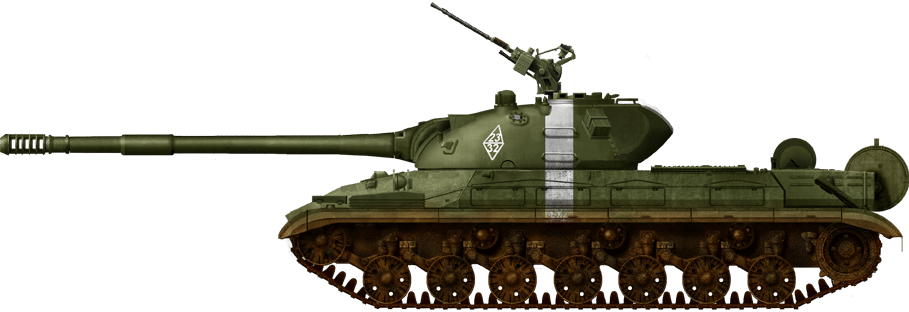
1439 built. Last heavy tank to be developed from 1950, the IS-8 had a longer hull, a relatively conventional turret but a revised armor new 120 mm gun with fume extractor, and a new diesel engine. With the death of Stalin it was renamed T-10. At 52 tons, this tank was produced until 1966.
The T-10/T-10M was the last of the heavy tank breed that never proved their usefulness since the emergence of far cheaper and faster tanks like the T-54/55s and especially the T-62.
Mediums & MBTs: From the T-54 to the T-80
Two extremes of the entire MBT lineage of the Warsaw pact: The 1950s, 1st generation T-54, and at the opposite, the third generation T-80. The T-54/55 and T-62s were relatively cheap and low-tech, mass-produced tanks, which were gradually discredited on the middle eastern and 1991/2003 Iraqi theater. The T-64 was a breed apart, a brave attempt to create second generation MBT right into the 1960s, which ended with the creation on a way in between with the T-72.
This was the true successor to the earlier types, well modernized in between, but also a true second generation MBT. The T-80 was the successor of the high tech T-64 and was mixed with the T-72M to create the T-90 just when Soviet Union collapsed. At that time, although these models seemed closely related, lessons learned about the soviet quantity over quality dogma, the balance gradually and surely leaning toward the second…
T-54 (1949)
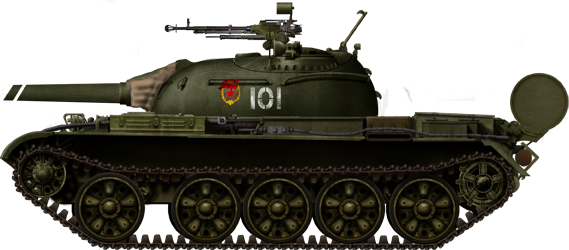
35,000 built. First medium tank of the cold war and a very famous one, it was still driven by the famous vision of “quantity has a quality in itself”. A simple and rugged the T-34 was this first MBT was developed through the T-44, and its entirely revised hull, but showcased a brand new hemispherical cast turret and 100 mm gun. When introduced in 1948 it was superior to anything in the west. Through modernization, it is still in service worldwide and had an extraordinarily active life.
T-55 (1955)
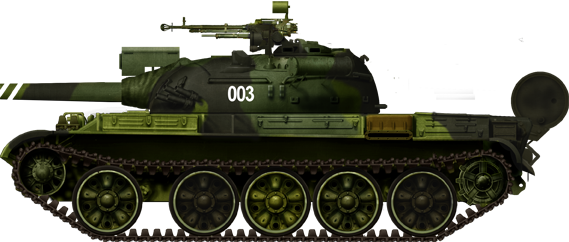
27,500 built. Basically, a modernized T-54 fitted with NBC protection and revised engine this very similar tank was also declined into multiple versions and sold to a considerable number of armies worldwide, seeing a very extensive service until today, through modernizations and conversions.
T-62 (1961)

22,700 built. The T-62 was an attempt to upgrade the main armament with a brand new 115mm smoothbore cannon and autoloader, and a stretched-out hull. However the new design had several issues (poor accuracy, faulty automatic ejector) which prevented its large adoption on the international market.
T-64 (1964)

12,000 built. The T-64 was a brand new design and leap forward, this very advanced tank was long into service and remained an “elite” MBT that suffered numerous delays and teething problems after its introduction. It introduced a new sophisticated FCS, new suspensions, new ultra-compact engine, new D-81T 125 mm smoothbore gun with entirely revised autoloader. However it never really made it on the export market as the T-72 was chosen instead.
T-72 (1973)

25,000 built. If the T-62 and T-64 never made it to the export market, the T-72 did and replaced in practice the numerous T-54/55s in service worldwide. It was derived from the T-64 and other alternative designs but was much simplified for mass-production and imposed itself inside the Warsaw Pact, also spawning lots of derivatives or licence-built version. Still widely used worldwide. One of its versions was derived into the actual Russian MBT, the T-90.
T-80 (1976)

5400 built as of 2005. The T-80 was a successor to the T-64, using the same basis. Most notably, it was the first MBT produced in any numbers to be fitted with a gas turbine for propulsion. It is now one of the main Russian MBTs in service with 3000 maintained active and 1800 in reserve, about 300 in Ukraine. Great commonality with the locally-produced T-64 also help for modernizations. The T-80 despite its high price tag was also a moderate export success with ten operators.
Light tanks

The PT-76 was the most common of the soviet light tank force, fully amphibious, it also formed the basis for many derivatives (APCs, command vehicles, SPAAGs, missiles launchers…). On the other hand, no less than four types of airborne vehicles were produced to match the requirement of paratroopers support on the field.
PT-76 (1952)
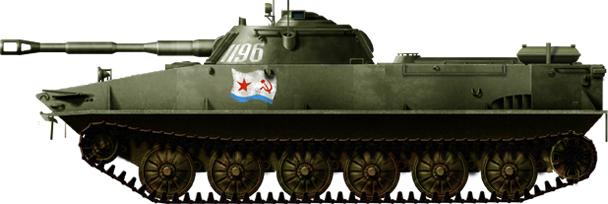
12,000 built. Amphibious tank. Designed in 1950 as a reconnaissance tank, it was light enough and had the right buoyancy to cross large rivers and lakes as well as assault by sea. Armed with the low-velocity 75mm gun and about 2000 were exported. At least a dozen known variants.
ASU-57 (1951)

500 built. A tankette tailored to be airdropped. Served only with the VDV (paratroopers corps), and armed with the Ch-51 57mm main gun. Retired and replaced by the ASU-85.
ASU-85 (1959)

The replacement for the ASU-57, still airborne SPG this time upgraded with an fully armoured roof and better 85mm high velocity gun capable to engage most Western Tanks. It was only used until the introduction of the BMD-1 which had the advantage to carry troops inside the vehicle (albeit a few).
BMD-1 (1969)
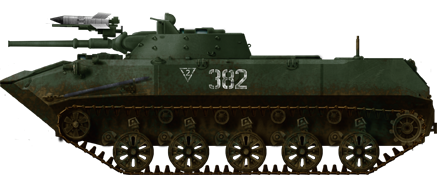
3000 built. First airborne IFV designed as such. A good package helped by the size of the new generation Soviet carrier planes and combining a troop compartment, low velocity 73mm gun, two LMGs and two ATGMs (with more in stock) intended to deal with tanks (the gun was more designed to deal with infantry and light vehicles or obstacles).
BMD-2 (1985)
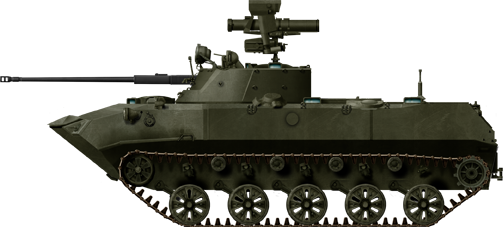
Replacement for the BMD-1 equipped with the 30 mm 2A42 multi-purpose autocannon, slightly larger according to the upgrade of Soviet carrier aircraft in capabilities. It was designed to replace the BMD-1 but failed to do so completely because of a production curtailed in 1991 with the Soviet economy collapse. It could be transported by the An-12, An-22, Il-76, An-124 and Mi-6, Mi-26 helicopters which like its predecessor, which gave it a fairly large array of tactical flexibility. It was superseded by the BMD-3 developed from the mid-1980s but only delivered from 1990 and an overall larger and more capable vehicle.
Infantry Fighting Vehicles
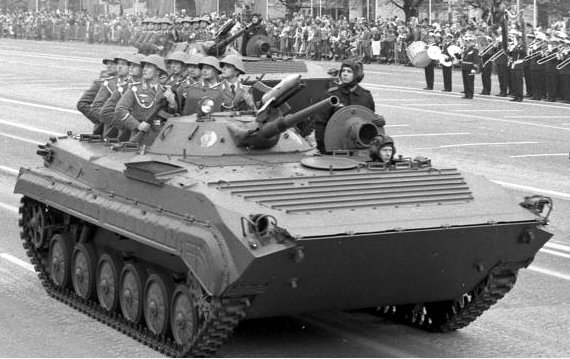
The BMP family literally from “Infantry Fighting vehicle”, is probably the most common type of IFVs ever to be found in the world, with a total of 50,000 vehicles, to compare with the 6,500 Bradley ever manufactured.
BMP-1 (1966)

20,000+ built. The most produced and famous IFV, largely exported, derived and produced under license. Could carry 3 crew plus 8 infantry, armed with a 73mm low velocity gun, ATGMs and KPVT light machine guns. However operations in Afghanistan and Chechnya showed its limitations in urban combat, low protection against mines and RPGs.
BMP-2 (1980)
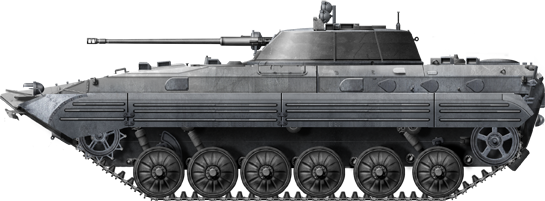
20,000+ BMP-2 built. Production records are difficult to established due to an intense license production (Czechoslovakia, India, Bulgaria), exports and conversions. Revealed in 1978 but only entering service in 1980 it was relatively similar to the BMP-1 but armed with a 30mm autocannon instead and eliminated all the drawbacks of its predecessor.
BMP-3 (1987)
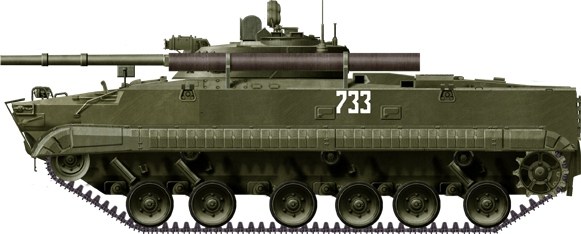
2000+ BMP-3 built. Developed in the Soviet era, it entered service just before the collapse of USSR. Therefore only a limited numbers were built, declined into 17 variants (Russia alone) and exported to 11 countries. The great novelty was the use of a 100mm gun/launcher 2A70 capable of delivering ATGMs (internal reload). It was coupled to a 30 mm autocannon 2A72 and three machine guns, quite a firepower for an augmented troop transport.
Armoured personal carriers
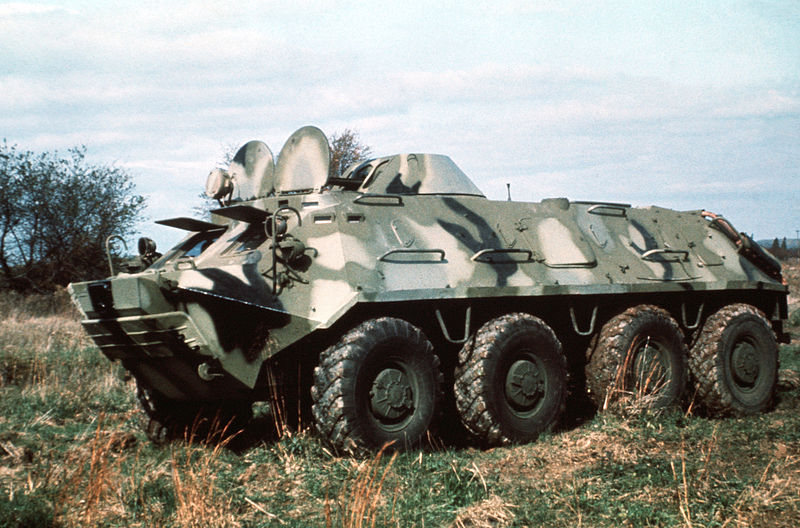
The BTR-40 was a 4×4 successor to the light wartime BA-64, and the BTR-152 was inspired by ww2 vehicles like the M3 half track. But the bulk of armoured troop transports was provided by the 8×8 Bronetransporters 60, 70 and 80, which were amphibious, NBC proven, with a better off-road motricity and also a cumulated 50,000 vehicles in all (real production figures are still ellusive). The smaller BRDMs were 4×4 well armed reconnaissance vehicles. The BMP-50 is the only tracked vehicle of the lot.
BTR-40 (1950)
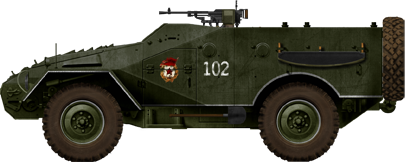
8500 built. Postwar APC, designed as a replacement for the mass-produced 4×4 BA-64 reconnaissance vehicle which was already used often as an APC despite its small size. The BTR-40 was much larger and had many improvements but was still open-top an, therefore, had no NBC protection (but for some specialized vehicles).
BTR-152 (1949)
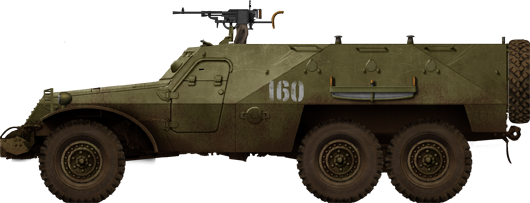
15,000 built. First Soviet dedicated Postwar APC (before that soviet troops only knew “tank desant”), this 6×6 wheeled vehicle recalled American and German ww2 half-tracks. A simple all-wheeled configuration was preferred with a central tyre inflation system that allowed to deflate tyres (and therefore create more contact surface) on soft grounds. Open top and therefore not NBC protected but for specialized variant with hard-top.
BTR-50 (1952)
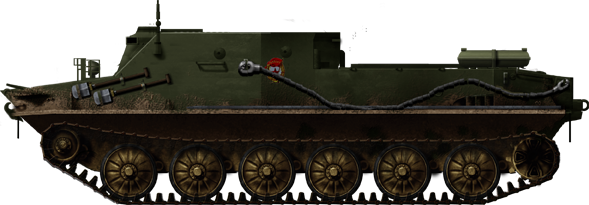
6,000 built. Tracked amphibious APC, although still not NBC protected. It was delivered to 20+ countries and declined into six main variants.
BTR-D (1985)
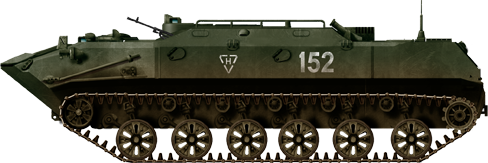
The BTR-D was a derivative of the BMD-1, the idea was to have an airborne APC, rather than an IFV that can only carry a symbolic crew and troops. It was introduced in 1974 and known by the west in 1979. In basic configuration, this 8.5 tons tracked APC (which shared a lengthened chassis with the MBD) only had a light PKT MG, but could carry a platoon, 10 troops, able to fire through portholes and roof hatches, yet protected against small arms fire overall. The front was even thicker by its slanted shape than on the BMD1/2. 11 versions has been done (production stopped in the 1990s with over 1000 delivered, kept by successors states), the last of which was the artillery support variant 2S9 “Nona”.
BTR-60 (1960)
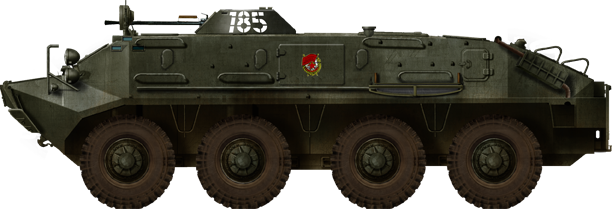
25,000 built. The proverbial Soviet wheeled APC, declined into dozens of specialized variants and largely exported. It was NBC-protected (on later variants) and amphibious. However its compartimentation with central escape hatches (rather than a rear door) made it difficult for the troops to operate in safety.
BTR-70 (1972)

5000 BTR-70 built. Less common but still well exported, this vehicle was given a heavier armament and more powerful engine. At least 30 known variants, Soviet or local, like the Romanian TAB-77.
BTR-80 (1986)
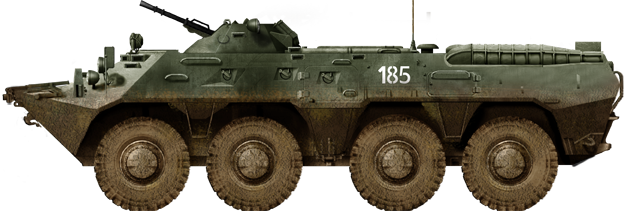
5000 BTR-80 built. Last soviet evolution of the type, with several modifications but the same armament, later declined into the BTR-90 and BTR-82 IFVs. It is the base for several Ukrainian sub-variants.
BRDM-1 (1957)
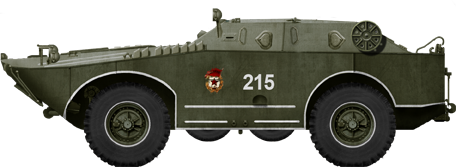
10,000 built. Amphibious reconnaissance vehicle. Also declined as a tank-hunter and many other variants. Well exported, mostly in Africa (about 50 countries).
BRDM-2 (1962)
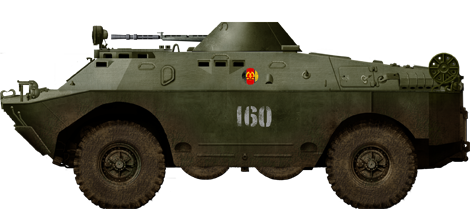
Modernized version, with a heavier armament and many more versions despite a lower production.
Self-propelled artillery
2S1 Gvodizka (1970)

The 2S1 Gvozdika (1970) was the most current Soviet self propelled artillery during the cold war, a vehicle equipped with a 122 mm gun howitzer in turret, very low compared to its Western equivalents. It was delivered in the tens of thousands until 1991 to fill the organic rôle of mobile artillery into each motorized rifle division or Tank division (72 or 36 respectively per unit), and was largely exported and also produced under licence by Poland, Romania, Iran, and Bulgaria.
2S3 “Akatsiya” (1971)
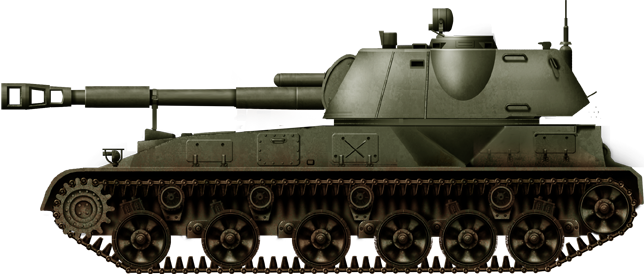
After the 2S1, people assume there was a 2S2, but it remained as a paper project and the program jumped directly to the next 2S3 (from nine models of Soviet self-propelled-guns during the cold war alone. The 2S3 “Akatsiya” (“acacia”, Soviet SPGs were traditionally namd after flowers) could be summarized as the Soviet response to the American M109, which developed started in 1967 and the prototype SO-152 tested in 1968, entering service in 1971. Armed with a 152.4 mm D-22 howitzer in a new larger turret compared to the 2S1, it was lightly armored (30 mm max) and a tailored chassis, engine, transmission and drivetrain that were reused for many other vehicles. Declined into six variants it was exported to 17 countries, some former Soviet republics after the USSR fall. Mass production ended in 1993, with around 3,500 vehicles (900+ active, 1600 in storage for Russia alone, 500 for Ukraine, etc.). It was a reliable vehicle but past 2000s, outranged by all modern Western SPGs.
2S4 “Tyulpan” (1972)
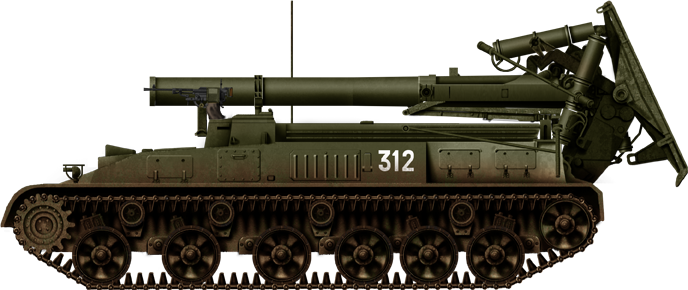
The 2S4 “Tulip” was developed in parallel to the 2S3, on the same chassis, but fitted with a 240mm mortar mortar instead, trading range for punch. When deployed, the mortar mount unit was to be pivoted to the rear, the base plate anchored in the ground, to be recoil-absorbing. The lenght of the tube and size of the rounds preventing all manual feed, an autoloader was used. Approximatively only 588 2S4 were built, which mortar could deliver HE rounds at 9500 m, and up to 20,000 with extended-range ammunitions. It was known by NATO in 1975 and production ran from 1969 to 1988. Outside USSR, only Czechoslovakia and Syria used it. They are now under modernization for the Russian Army.
2S5 “Giatsint” (1972)
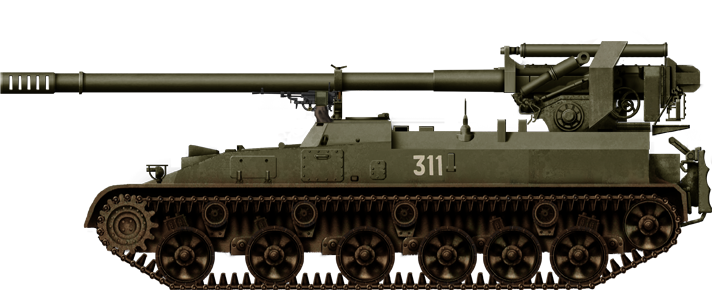
The “Hyacinth” was another SPG based on the same chassis, which left the crew unprotected. It was developed in 1967–1974, and produced from 1976 to 1991 to replaced the towed 130mm M46 field guns, replaced by this self-propelled 2A36 152 mm gun (5.98 in) which can reach a target at 28 km, up to 40 with assisted projectiles. Production was about 1,100 given the exports and listed vehicles, either in service or storage in Russia. Outside Russia, it is used by Ethiopia, Finland, Belarus, and Ukraine.
2S9 “Nona” (1985)
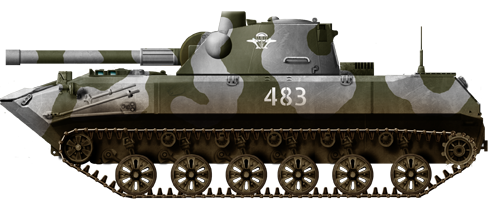
NONA meant “Newest Ordnance of Ground Artillery”. Developed from 1974 it was a way to provide to the VDVs (airborne divisions) a light-weight self-propelled, air-droppable 120 mm gun-mortar. It entered service in 1981, based on the S-120 aluminium hull derived from the BTR-D armoured personnel carrier (which had an extra wheeltrain). This 8.7 tons 120 mm mortar 2S9 Nona and Nona-S was used at least in two conflicts, the Syrian Civil War and the war in Donbass. Production is unknown but probably over 1000. It was also used by Syria, Kazakhstan, Ukraine and Venezuela. The BTR-80 was converted with the same system as the 2S23 Nona-SVK. There was even a tower versions called 2B16 Nona-K.
ZSU-23-4-Shilka (1962)
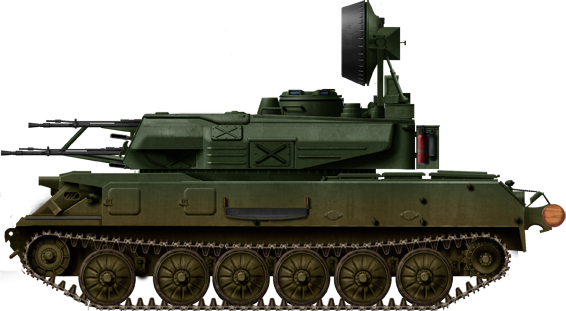
The Zenitnaya Samokhodnaya Ustanovka 23 (mm) -4 (tubes) “Shilka” because of the Shilka River was really the first, modern mass-distributed SPAAG of the cold war. It was a replacement for the 1950s “Sparka” or “pair”, the ZSU-57-2, a more crude weapons systems. The new weapons system was to correct any deficiencies of the previous vehicles, like the innacuracy, lack of radar, and impossibility to fire on the move or the small supply of ammunitions. Developed from 1957 to 1962 it really entered service with much more than the USSR and Wardsaw Pact, but the 6500 allegedly built by Mytishchi Engineering Works (MMZ) until 1982 served with more than 40 operators around the world. There were a dozen of variants, including modernizations like the 4M of 1973 or the Russian ZSU-23-4M5 augmented with MANPADS and new electronics, radar and digital calculators in 1999, mostly as an upgrade kit for export. It has been replaced since by the “Tunguska” in the Russian arsenal.
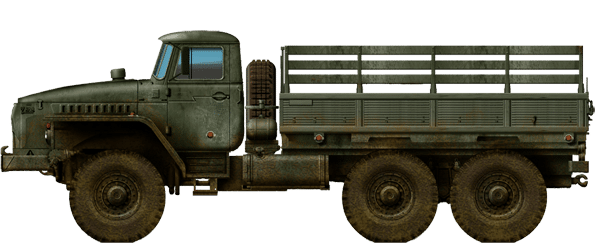
The basic vehicle, in standard configuration & open bay.
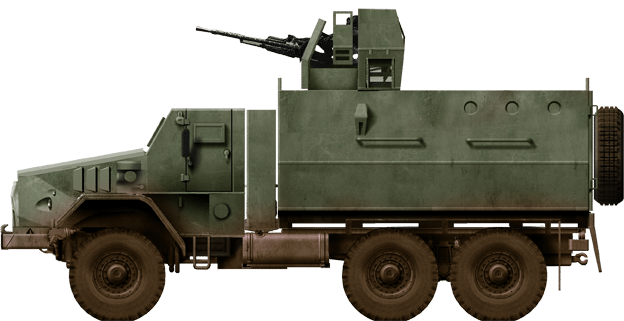
Angola used thse trucks in the 1980s Angola conflict with south africa, and sub-groups like FAR used them as weapon platforms, usually for ZPU AA mounts, and in this case, a rare armored APC also with a ZPU-2 Mount. Capacity seems to have been ten infantrymen. The engine front, top, and cab are all armored. A spare roadwheel is placed at the rear, one one of the two doors.
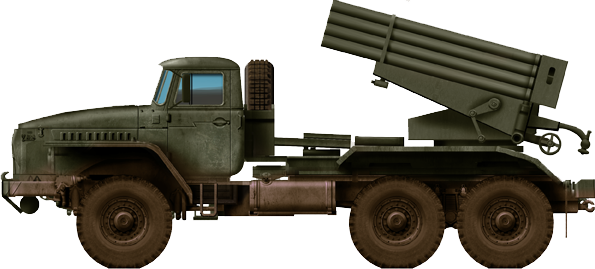
BM-21 RL
Soviet cold war related links
Soviet armour (generic) on Wikipedia
Google Book – Soviet Military Operational Art of Deep Battle
Illustrations

BMP-1 (Ob’yekt 765Sp1 which stands for spetsifikatsiya – specification), first pre-production vehicle in testings, 1964. Note the absent side skirts. It had a shorter nose section than the prototype and a larger angled plate, swim vanes modified, raised fender profile, fume extraction ports moved outwards, twin torsion bar spring for the rear roof troop hatches and moved firing ports higher up in the armour plates. This model 1966 was built until 1969.

BMP-1sp2 (NATO model 1970), standard production of a rifle motorized brigade, fall early 1970s. This was version was produced until 1973. Roomier, with an elongated nose section, raising circular telescopic snorkel, rearranged roof hatches, front left side air intake removed, NBC filter cover and new PKM port.
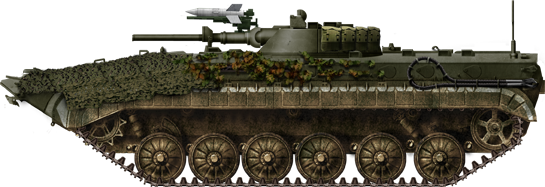
Soviet BMP-1 model 1973 with camouflage nest in exercises (Ob’yekt 765Sp2), fall 1970s. Assimilated as the model 1973 with the sp3 by NATO, but the first version inaugurated a whole series of novelties, from the semi-automatic 9S428 ATGM guiding system and gun stabilization, improved NBC, engine, autoloader, and improved vision devices.
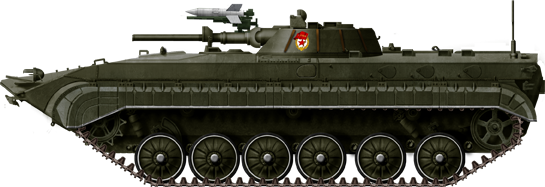
Camouflaged BMP-1 model 1973 (Ob’yekt 765Sp3), in may parade colors. The sp3 introduced a new OG-15V HE-Frag round in its ammo supply and the accompanying 1PN22M2 sight, a modified traffic signal system some additional protection and the 3 autoloader removed; It was 200 kgs heavier and was known by NATO as the BMP M1976.
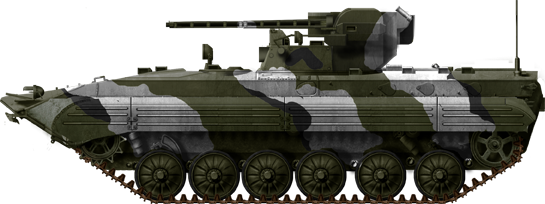
BMP-1M “Shkval”, the modernized version of the BMP-1M fitted with 2×3 81 mm 902V “Tucha” smoke grenade launchers at the rear of the turret. The designation was never official, only used by NATO. It was preceded by the MP-1 M1979/1 (Ob’yekt 765Sp8), sometimes designated by NATO BMP-1G, armed with a 30 mm AGS-17 “Plamya” automatic grenade launcher.
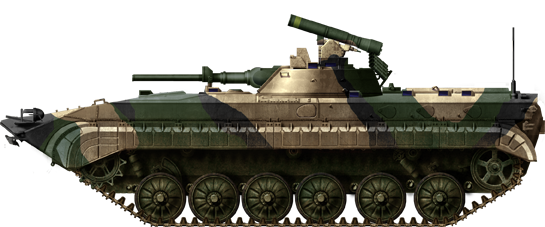
BMP-1P or M1981 (Ob’yekt 765Sp4). 9P135M launcher with semi-automatic control for SACLOS 9M113/M “Konkurs” ATGMs, or 9M111 “Fagot” and “Fagot-B”, new improved NBC lining, new automatic fire extinguishers, additional machine gun firing ports (left side of the hull, front of the turret). 9M32M “Strela-2M”/ 9M313 Igla-1 or MANPADS. Produced from 1979 to 1983.
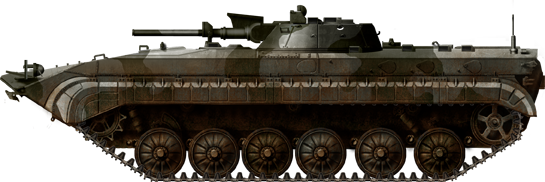
Soviet BMP-1 with partial add-on protection in Afghanistan, 1980s. Many damaged and recovered BMP-1s were converted back as BMP-1D, th so-called “Afghan variant”; Produced from 1982 this assault version (hence the “D” for “desentnaya”) had add-on armour on the sides, armoured panels protecting the suspensions, add-on armour behind the commander and driver’s seats, additional troop’s rood hatches pistol ports and a Plamya grenade launcher.
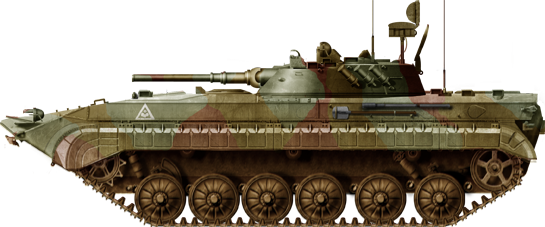
BMP-1K (Soviet command version). (The “K” stands for komandirskaya or command). Developed in 1972 it kept its standard armament but the troop compartment houses field tables and map boards and seating for three officers. Additional antenna, R-123M and R-111 radios, GPK-69 navigation system. Firing ports welded shut. Optional GLONASS navigation system. (NATO designation M1974). Three known sub variants K1/K2/K3 Platoon/Company/Battalion with variation in radio equipments.
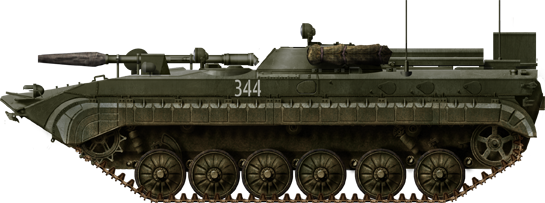
Soviet BMP-1KSh (“KSh”stands for komandno-shtabnaya – command and staff) (NATO M1978), motorized rifle/tank regiment. It was given a TNA-3 gyroscopic navigation, 2 R-111, 1 R-123MT,1 R-130M radios, field telegraph/telephone. Armament replaced by the AMU “Hawkeye” telescopic mast and its right rear hull tubular case (10 m when up) plus fixed turret. There was also an AB-1P/30 1 kW box-shaped portable petrol-electric generator (center rear hull roof replacinf the outer hatches) plus four whip antennas. 13 tonnes, crew of 3 + 4 operators armed with a single 7.62 mm PKT.Pproduction start in 1976, in action in Afghanistan and Chechnya.

BRM-1 (Ob’yekt 676) reconnaissance variant (1972)(NATO BMP-R/BMP M1976/1). It was equipped with an extensive electronic reconnaissance equipment. Conversion performed at the Chelyabinsk Tractor Works (ChTZ) fall-1960s to early 1970s and continued by the Kurgan Engineering Works (KMZ). Extra-wide, low-profile, two-man turret moved to the rear of the hull generally without the ATGM launcher, two small roof hatches, PSNR-5K (1RL-133-1) “Tall Mike” telescopic ground surveillance radar (housed in the turret’s rear), 1D8 laser rangefinder, TNA-1/3 gyroscopic navigation systems (with coordinates recorder) plus additional R-123M, R-130M, R-148 and R-014D radios (range up to 50 km to 300 km with the radio mast). The radar, had two modes, terrain survey and target tracking, and can detect vehicles up to 7000m or personnel up to 2000m around. A doppler radar for range calculations was installed from 1993 onwards. Tactically, one was assigned pere recce company. Some had in addition 2×3 81 mm 902V “Tucha” smoke grenade launchers.

Soviet PRP-3 “Val” (NATO M1975) artillery reconnaissance vehicle. Also known as the (Ob’yekt 767 1ZhZ) (PRP stands for podvizhnoy razvedyvatel’niy punkt or mobile reconnaissance post) and sometimes BMP-SON.. Production started in 1972 (Kurgan Engineering Works) and 1979 (Rubtsovsk Engineering Works) and it received two R-123M or R-108 radios, optical devices for artillery/guided missile target indication, adjustment and target locating. Just one PKT machine gun was ball-mounted in front of the large flat two-man turret which cover the first rear hatches. This turret had two forward-opening hatches with periscopes for observation and optics. The right hand side of the turret was given a huttered optic. 1RL126 “Small Fred” counterbattery and surveillance radar was mounted in a circular hatch cover located rear left of the turret. It operated in the J-band with a 20 km detections range, 7 km tracking range. This equipment was completed by 1V44/1G13M/1G25-1 navigational systems, 1D6/D6M1 laser rangefinder, 10P79 vision device, 1PN29 night vision device and 90 mm 2P130-1 launcher (20 9M41 illumination missiles). The crew of 5 manned the vehicle, affected to artillery/guided missile battalions and the target acquisition battery of an artillery regiment.
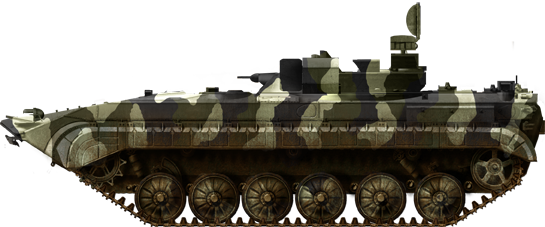
Russian PRP-4 “Nard” (Ob’yekt 779, 1V121). Modernized version of the latter, which entered service in the 1980s. Equipment comprised the 1A30M and two R-173 radios, 1G25-1/1G13/KP-4 navigational system, 1D11M-1 active pulsed laser range finder, 1PN59 thermal vision, 1PN61 active pulsed night vision. The radar was also upgraded, to an 1RL-133-1 “Tall Mike” retractable battlefield surveillance radar. Optical devices located either side sof the turret received protected mountings. In addition new electronic data processor and ann auxiliary power supply were mounted. It was produced by the Rubtsovsk Engineering Works. Later on which procuded the PRP-4M “Deyteriy” (1988) which was given a 1PN71 thermal IR vision device (3,000 m range), 1D14 periscopic laser rangefinder, 1D13 portable laser reconnaissance device and a turret antenna mounted behind the radar hatch. The PRP-4M “Deyteriy” was also sometimes given a fake gun mantlet and offset gun barrel to look like a BMP-2. The latest upgrade was the PRP-4MU which had an 1RL-133-3 retractable battlefield surveillance radar (12,000 m range), 1D14 periscopic laser rangefinder (10,000 m range) and T-235-1U data transmetter. This upgrade started in the late 1980s and the vehicle is used at regimental level.
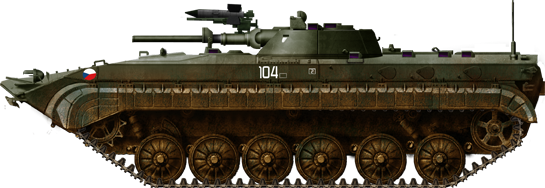
Czech BVP-1 (licence-built) VOP 026 Excaliburarmy.
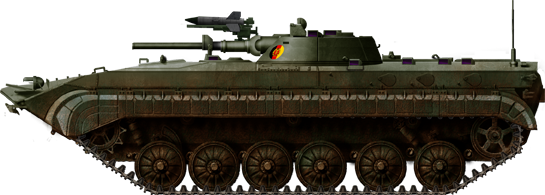
East-German BMP-1 – 1,133 were ordered in 1974 and delivered between 1974 and 1982 (some Czechoslovakian-built)
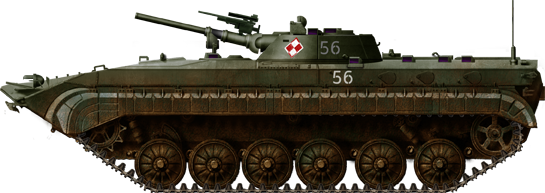
Polish BMP-1, 1970s
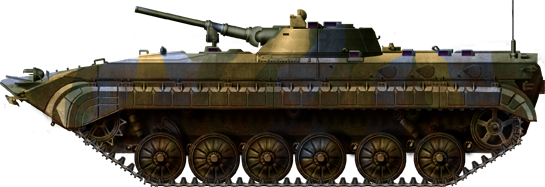
Syrian BMP-1 captured in 1973 and now displayed at the Latrun museum
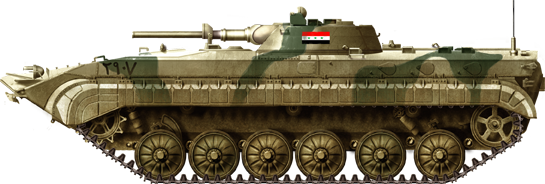
Iraqi BMP-1 in the Iran-Iraq war of the 1980s.
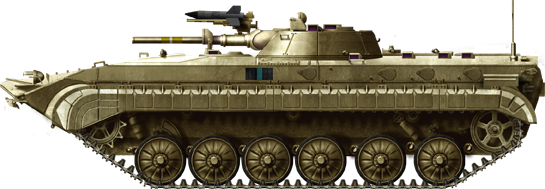
Iraqi BMP-1 of the Mechanized Regiment, 6th Armoured Brigade, 3th Armoured Division “Saladin”, Kuwait 1991.
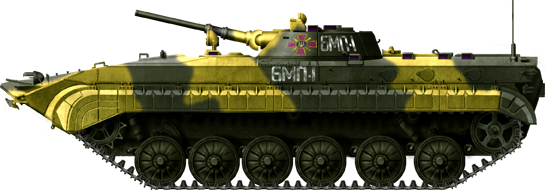
Ukrainian BMP-1, 1990s.
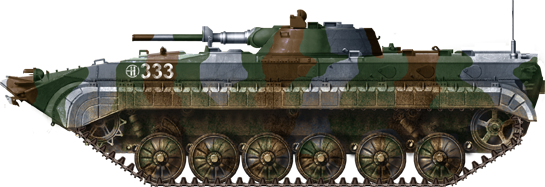
Georgian BMP-1, 2000s. These have seen extensive action against muslim guerilla fighters until recently.
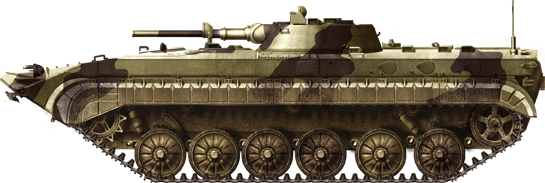
Iranian BMP-1. A local version is produced since, the Boragh, which came in multiple confirgurations.

Iraqi’s Republican Guards BMP-1 in 1991.
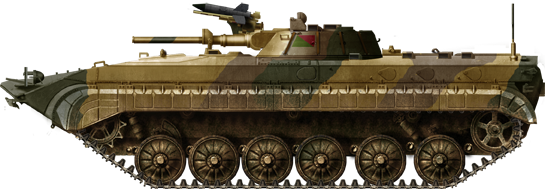
Egyptian BMP-1 of the 4th armoured division, Sinai front, Yom Kippur war 1973.
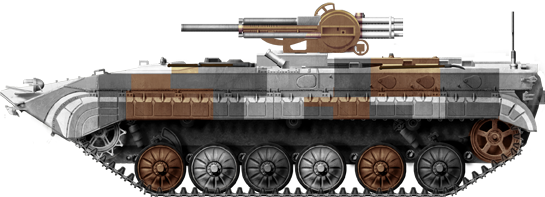
Kazakhstan modified BMP-1 fitted with a 2B9M Vasilyok 82 mortar.

Syrian BMP-1 recently photographed, 2014, Syrian civil war.
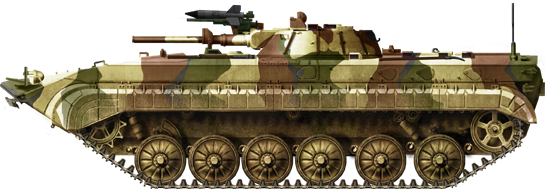
BMP-1 Azerbaidjan Army – camouflaged inspired by the BMP-2 in Azeri service.
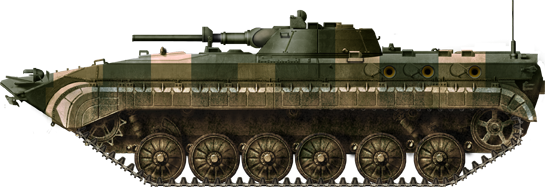
BMP-1, Morocco ground forces.
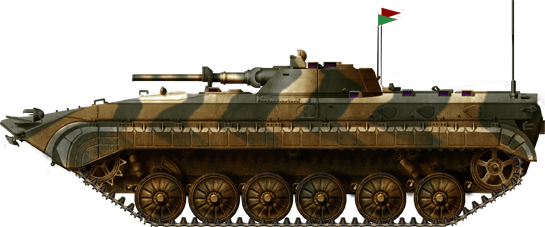
Indian BMP-1. From 350 to 700 has been ordered in 1982, delivered until 1989, while some 100 to 450 were produced and currently less than 700 are in active service or reserve. Since replaced by the BMP-2 “Sarath” locally produced under licence.
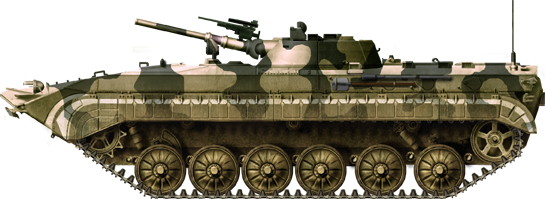
Lybian BMP-1. Many were captured by the Saharan insurgents and later passed onto the US Forces for analysis.
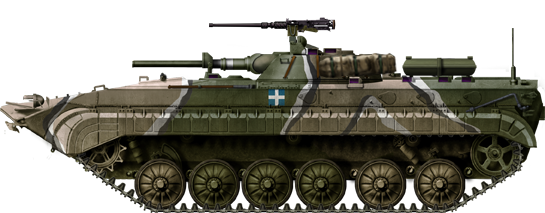
Greek BMP-1. These were former vehicles from West Germany, reconditioned to NATO standard.
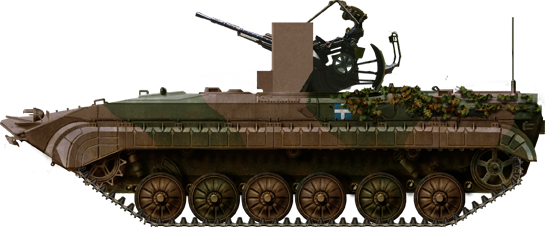
Greek BMP-1/Zsu-23-2 SPAAGs. Conversions started in 2014 and are ongoing.
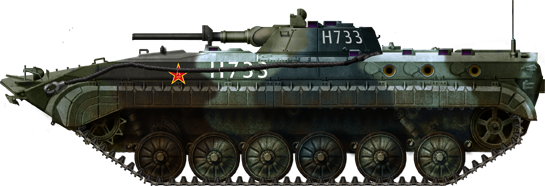
Type 86 IFV, a Chinese reversed engineered version of the BMP-1. First tests in 1986, production started in 1987. About 1,000 to 3,000 (based on the same chassis) produced, it entered service in 1992 and has been largely exported since.
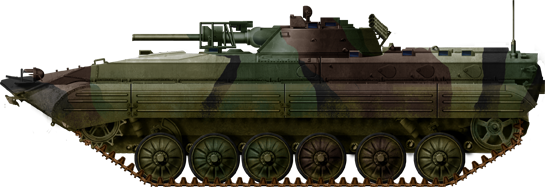
Slovakian BzVP-1.
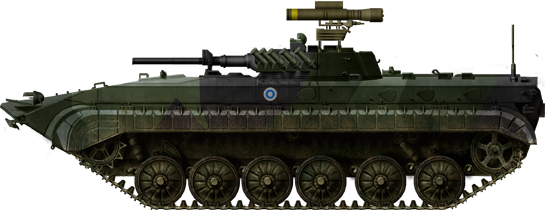
Finnish BMP-1FI, a local variant of the BMP-1P.

BMP-2, as of 1980
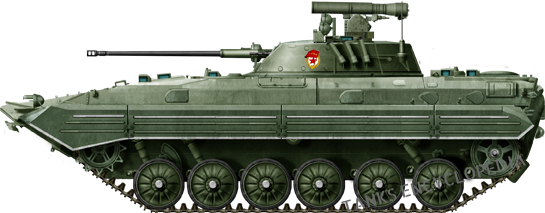
BMP-2, 1982 Moscow parade
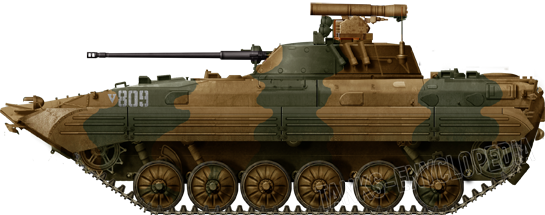
BMP-2 in Afghanistan, early 1980s
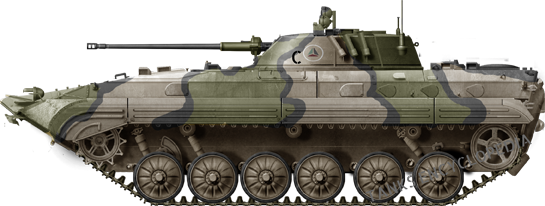
Afghan BMP-2
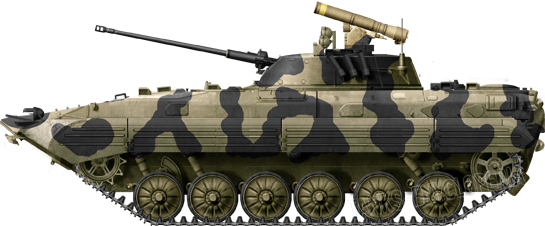
Algerian BMP-2
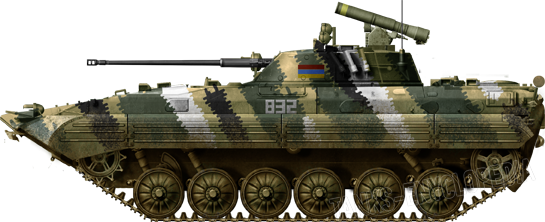
Armenian BMP-2
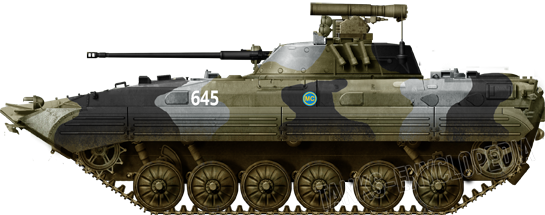
Russian BMP-2a in South Ossetia, 2008
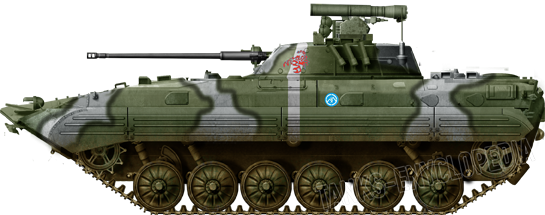
Ukrainian BMP-2a as of 2014, Donetsk
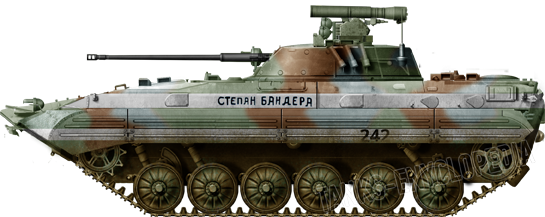
BMP-2 in Ukrainian service – Stepan Bandera, Donetsk 2014
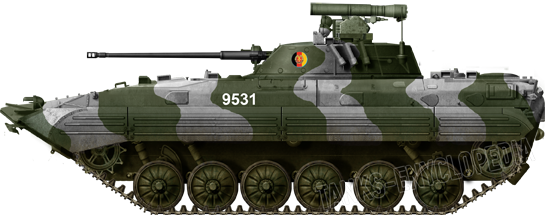
BMP-2 Est Germany, winter 1988 guards regiment
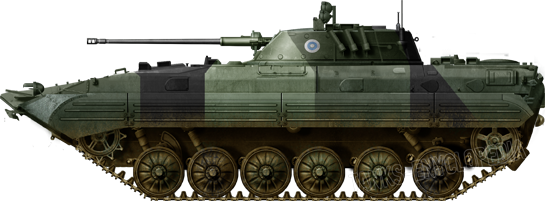
Finnish BMP-2
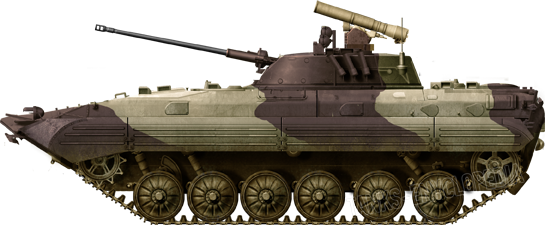
Iranian BMP-2
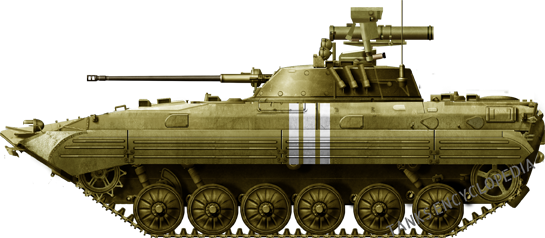
BMP-2 of the Kuwaiti Army
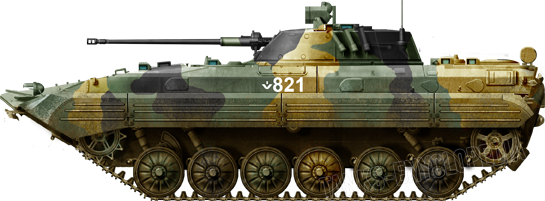
Russian BMP-2
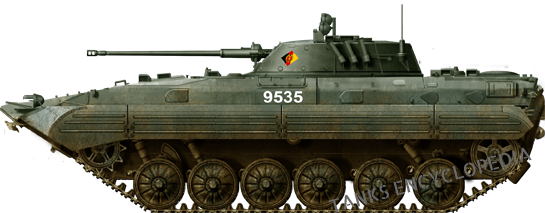
East German BMP-2, Motorschtz. regiment 29, Rud. Ren. 9th PZD, 1988
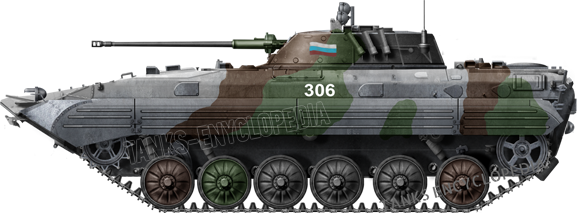
Russian BMP-2, 1994

Indian BMP-2 Sarath
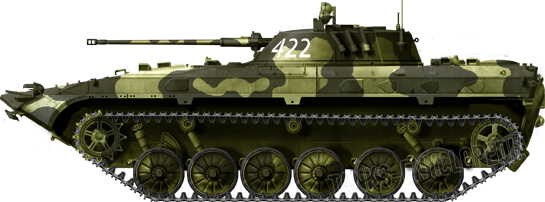
BMP-2 U422
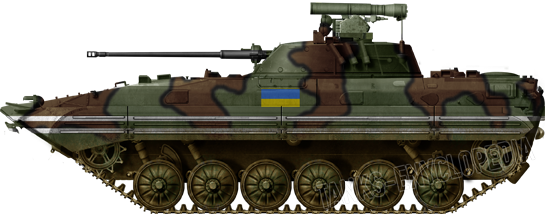
Ukrainian BMP-2 in 2014

Early BMP-3

Camouflaged BMP-3, 2 tone camouflage

BMP-3 KFOR, ex-Yugoslavia, 1995

Russian camouflaged BMP-3

UAE BMP-3 ERA

UAE BMP-3

Russian BMP-3

South Korean BMP-3

9P157-2 “Khrizantema-S version.

BMP-3F Marinir (Indonesian Marines)

Russian camouflage

Cypriot BMP-3

BMD-1, early production, 1969. The first were built with a magnesium alloy hull, quickly replaced by aluminium for production as it was shown that the latter was prone to burn furiously.
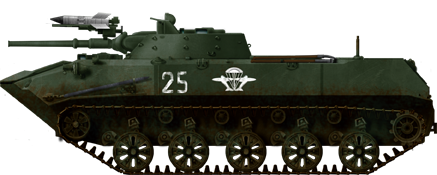
BMD-1 of the VDV in the 1970s. In addition to the main gun, bow machine guns and ATGMs, this IFV had three firing ports, from which can be fired RPG-7 or 16, RPKS light MGs and five AKMS assault rifles.
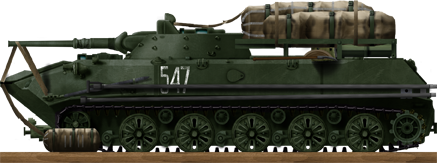
BMD-1 being prepared for a pallet jump from a Ll-76.
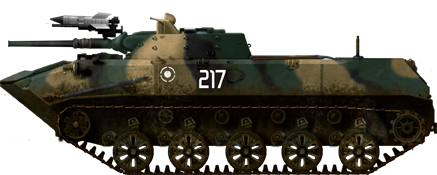
Camouflaged BMD-1 of an unknown VDV, 1980s.
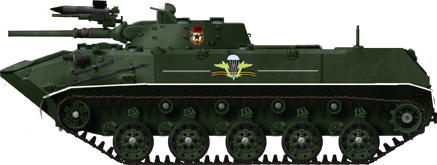
Late type BMD-1M in parade colors
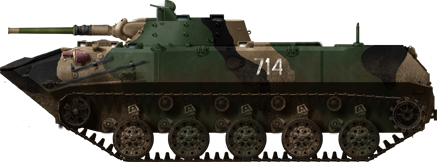
Camouflaged modern BMD-1P, 1980s
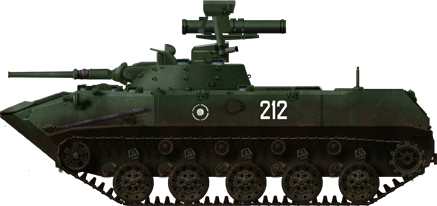
Modernized BMD-1P with a pintle-mounted 9M111 “Fagot” ATGM (NATO AT-4 Spigot)
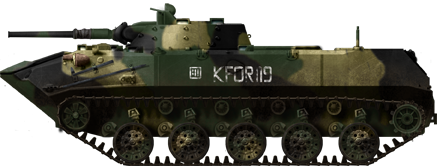
Russian BMD-1M of the KFOR in Kosovo, 1999.
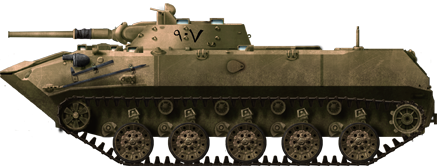
Iraqi BMD-1M, 1990. Only ten were acquired but apparently the suvivors of both 1990 and 2003 wars were scrapped.
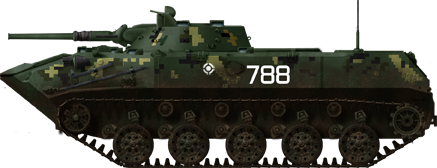
Ukrainian BMD-1M as of today (around 60 in service). Notice the digital camouflage.
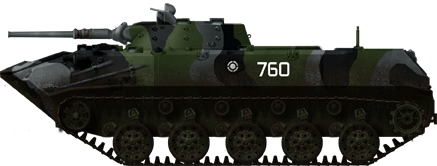
Azerbaidjani BMD-1 with a grey-based 3-tone camo (around 41 in service).
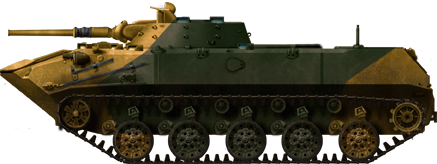
Indian BMD-1M, pending modernization (around 600 in service).
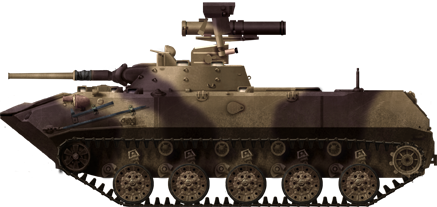
Iranian BMD-1P.
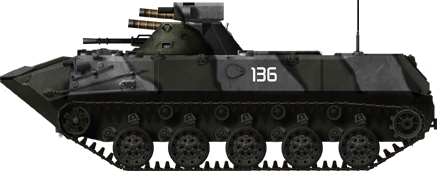
Belarus army BMD-1M with one-man 2A42 Cobra turret as of 2014

Barebone BMD-2 early production, note the BMD-1 roadwheels
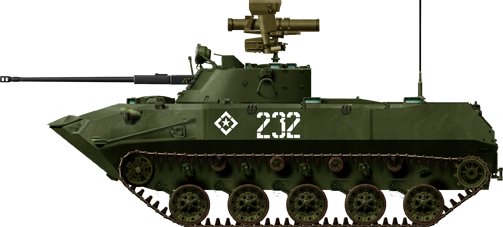
Early BMD-2 of the VDV in 1990
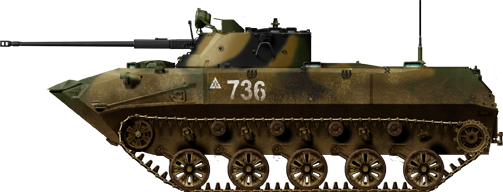
Camouflaged BMD-2 of the VDV, 1994
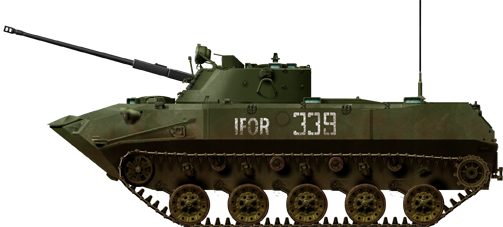
BMD-2 in Bosnia with IFOR, winter 1993-94
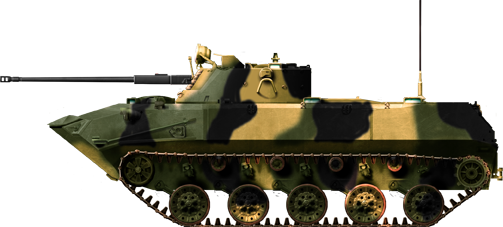
Unidentified camouflaged BMD-2 of the VDV
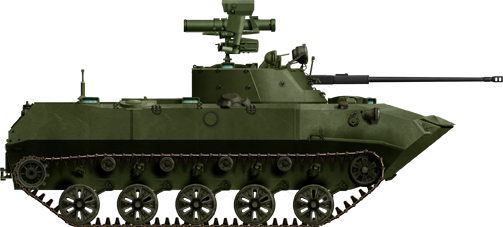
BMD-2 in tests
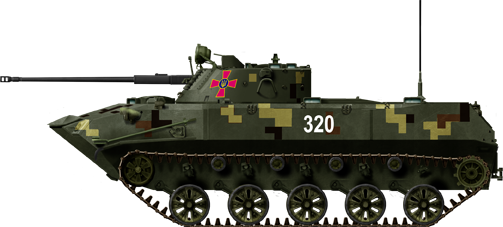
BMD-2 of the Ukrainian Army during a 2014 parade in Kiev. Note the “digital” pattern camouflage
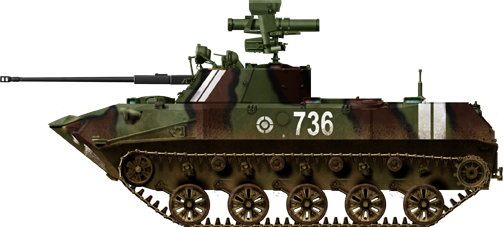
Ukrainian BMD-2 during the Ukrainian crisis, 2018

Standard ASU-57, as delivered. Only the rear is covered by a tarpaulin.

Another ASU-57, unknown parachute unit.

ASU-57, unknown parachute unit, 1960s.

ASU-57 now kept at the Parachute infantry museum in Ryazan.

ASU-57 in sand olive livery for operation in Ukraine, summer.

Egyptian ASU-57, war of 1967.

ASU-85 of unknown Soviet VDV unit.

ASU-85 of unknown Soviet VDV unit.

ASU-85 of unknown Soviet VDV unit.
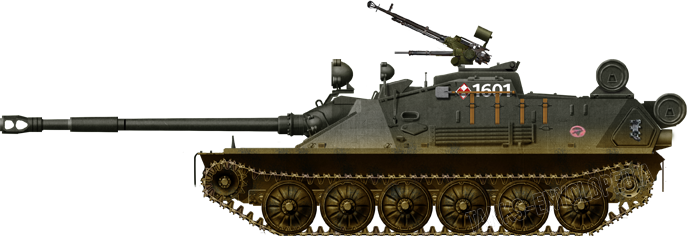
ASU-85M Polish 6th Air Assault Division.
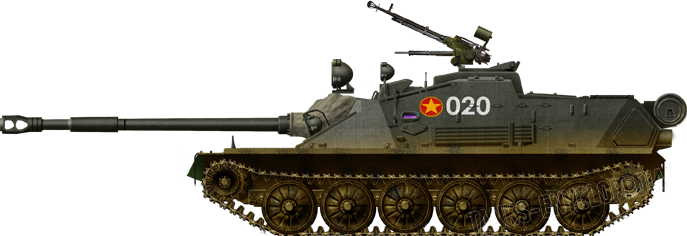
Vietnamese ASU-85M.

Standard Soviet Army BTR-152 of the early open-top model, Eastern Germany 1950.
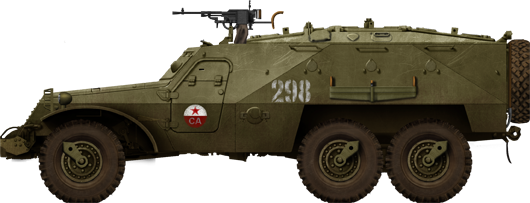
BTR-152 K, 1955.

BTR-152 V1 from an Egyptian infantry division, 1967 war.

BTR-152 V, two tone camouflage, Soviet unit, 1960s.
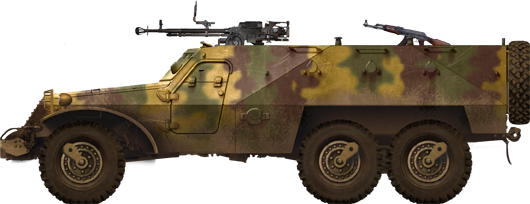
Modified Irakian BTR-152 K Iran-Irak war 1986 with a 12.7 mm DShK 1938/46.
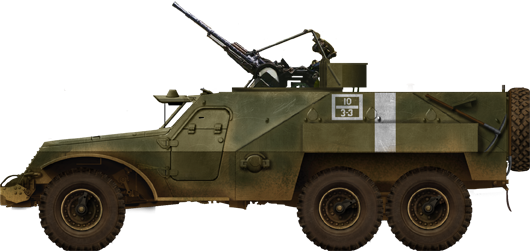
Standard Soviet Army BTR-A SPAAG, with a twin mount ZPU-2.
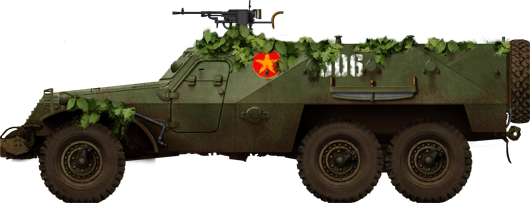
BTR-152 V1, North Vietnamese Army, Ho Chi Minh trail, 1969
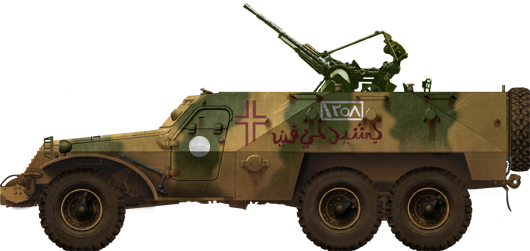
BTR-152 E, Lebanese Christian Militias, Beyrouth, 1985.

BTR-40, early production, 1950.
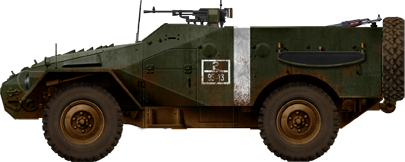
BTR-40, invasion of Hungary 1956.
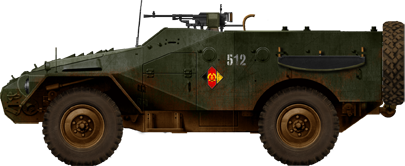
East German BTR-40.
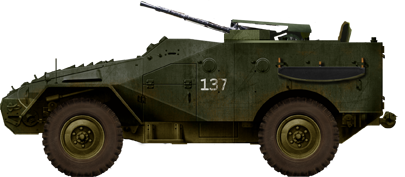
BTR-40A, the SPAAG version with a twin ZPTU 14.5 mm autocannon.
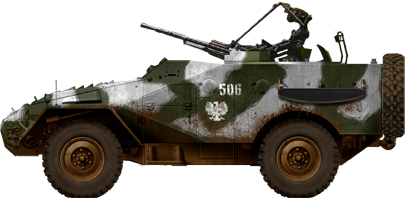
Polish BTR-40AZhD, winter exercizes, 1959.
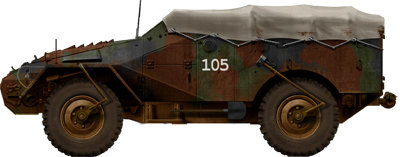
BTR-40v, equipped with the pressure regulation system, here in a camouflaged livery, 1960.
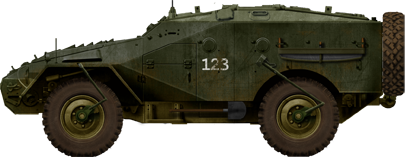
BTR-40B, the topped NBC version, 1957.
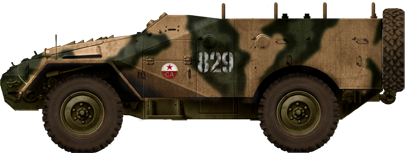
Camouflaged BTR-40, 1970s.
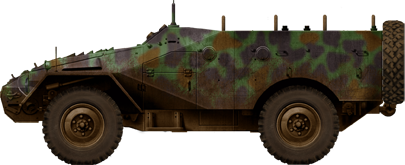
Surplus BTR-40 used for training, 1980s.
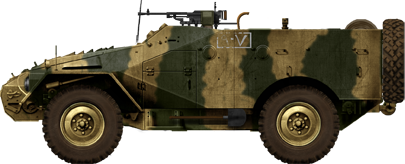
Egyptian BTR-40, war of 1967.
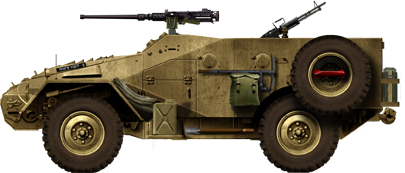
Israeli BTR-40, 1970s.
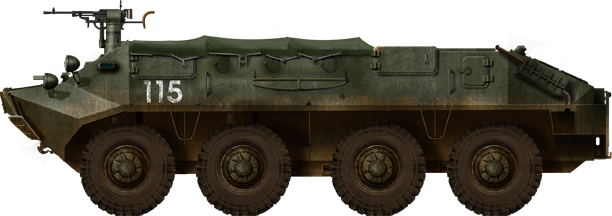
Early production BTR-60P of an unidentified rifle battalion with canvas, 1961-64.
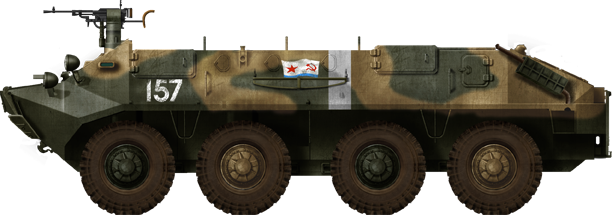
BTR-60P of a Marines rifle batallion, 1970.
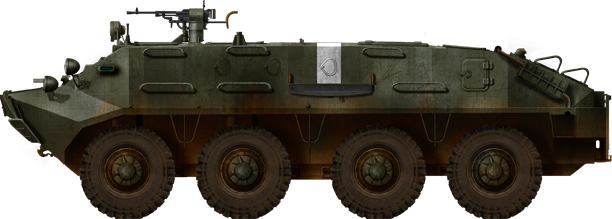
BTR-60PA, 1965.
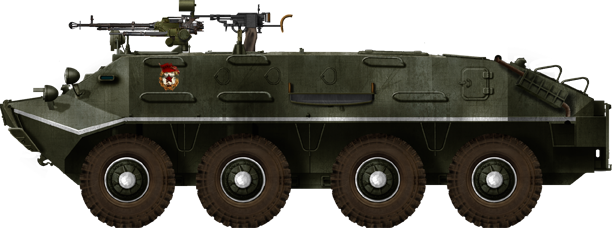
BTR-60PA, may 1969 victory parade, Moskow. Notice the armament of one DSHK HMG and two pintle-mount PKT MGs.

BTR-60PB soviet army guards unit, 1970.
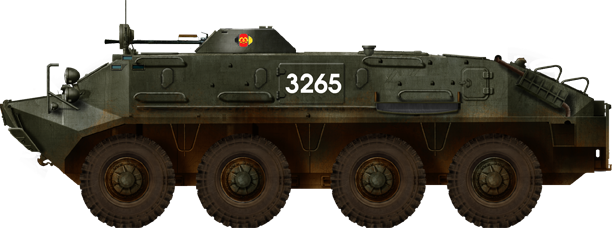
East German SPW-60PB, 1970s.
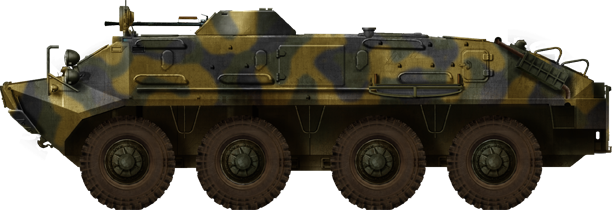
Syrian BTR-60PB, 1980s.
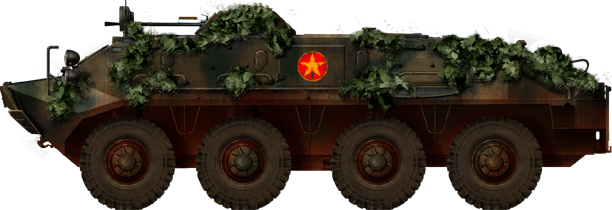
NVA army, 1972 offensive on Saigon.
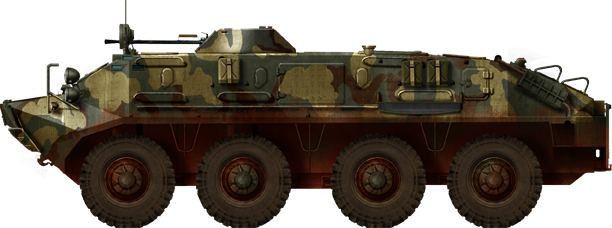
Camouflaged BTR-60PB of late production, 1970s
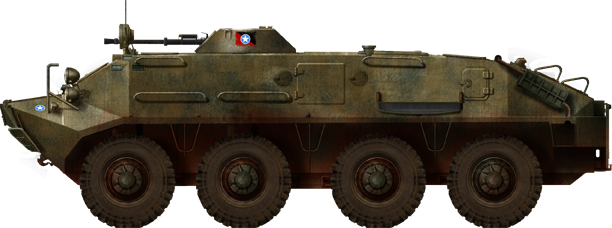
Somali BTR-60PB, 1990s.
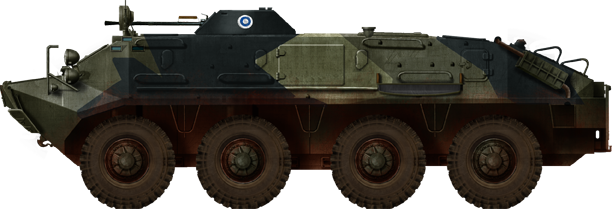
Finnish BTR-60 PB
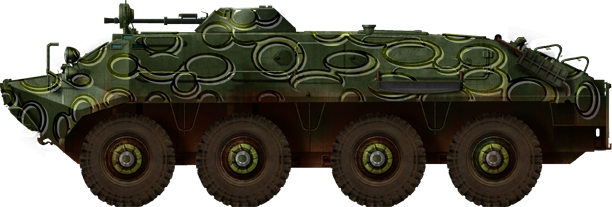
BTR-60 of the Afghan-Northern Alliance with its specific, rare camouflage.
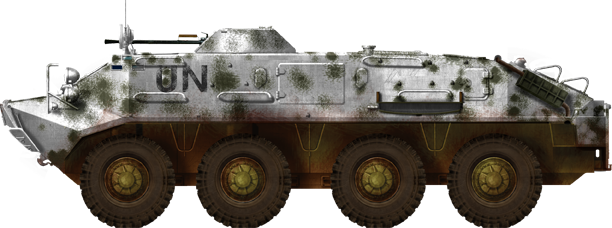
UN peace keeping forces BTR-60PB in Sierra Leone, 2002.
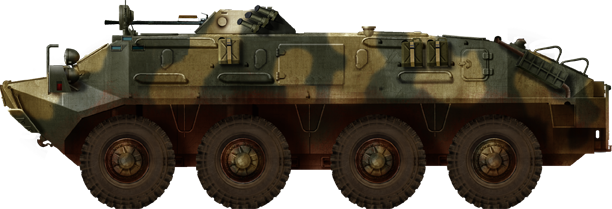
Algerian Forces BTR-60PB

Mexican Marines specialized vehicle
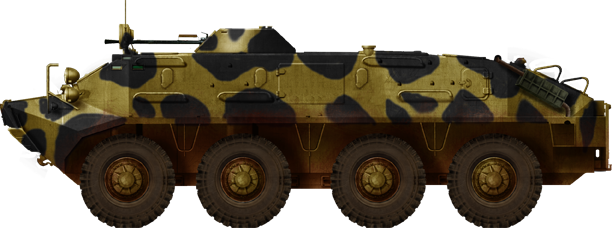
Libyan BTR-60, as of 2011.
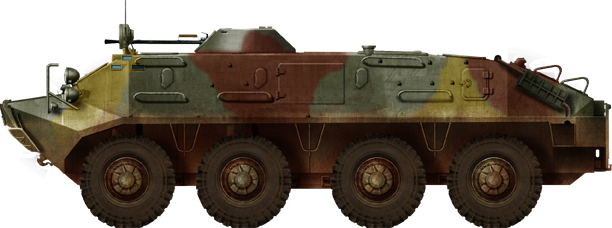
Egyptian BTR-60 in 1973, now displayed at Yad-La-Shiron Museum.
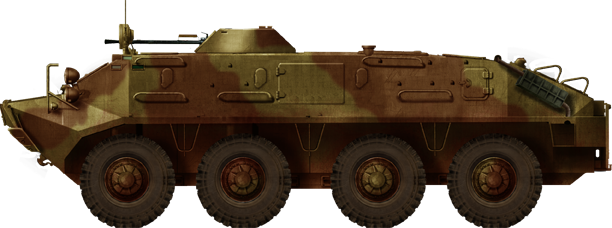
Iranian BTR-60PB
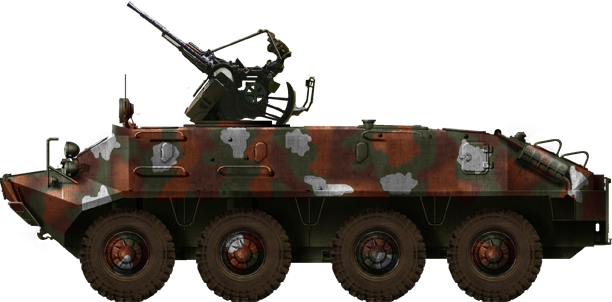
Iranian AA conversion of the BTR-60
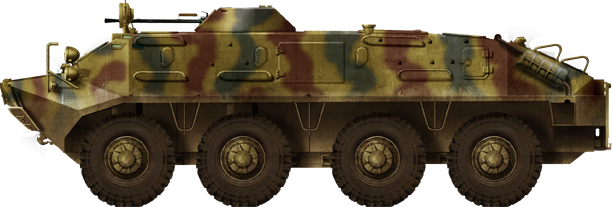
Yemeni BTR-60PB
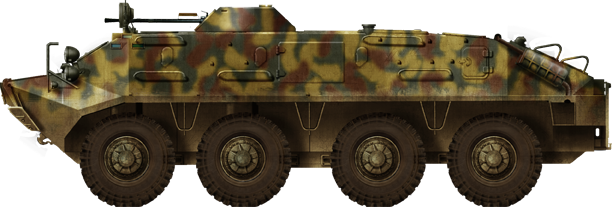
Bangladeshi Army BTR-60PB
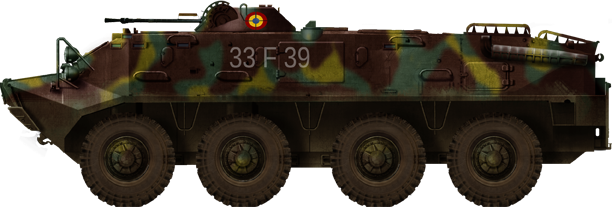
Romanian TAB-71
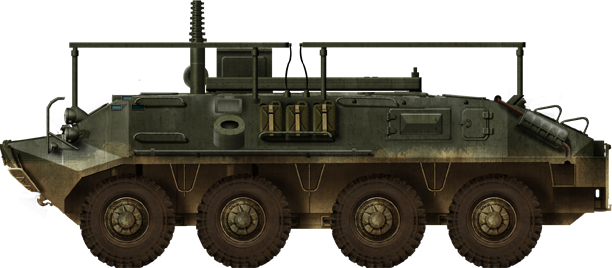
BTR-60PU-12 Air defence HQ vehicle
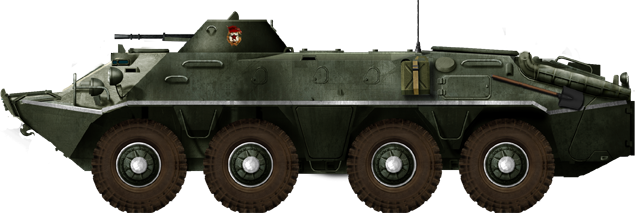
Early production BTR-70, first batch, in May 1981 Moskow parade.
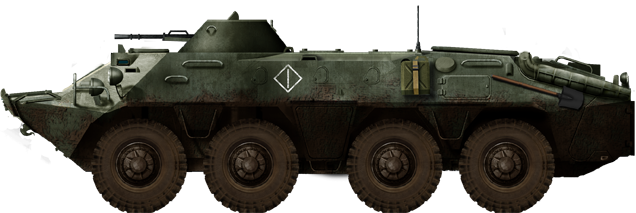
Early BTR-70 obr.84 of the rifle motorized regiment in Afghanistan, 1980-89

BTR-70 Obr. 86 in operations, late 1980s

East German SPZ-70, 24th Mot. Schützenregiment “John Scheer”, 4th Mot. Division, Erfurt 1985.
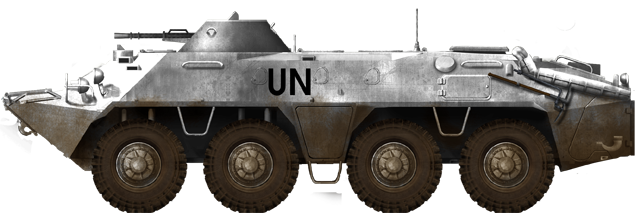
Early BTR-70 in peacekeeping operations, 1990s
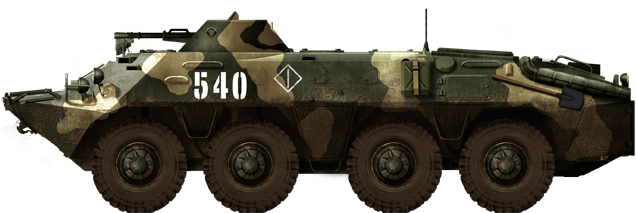
Mid-production type in Afghanistan, 1980-89.
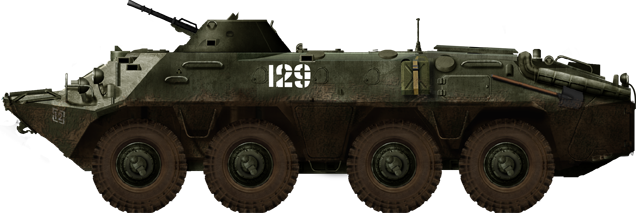
Late type, unkown soviet unit, fall 1980s.
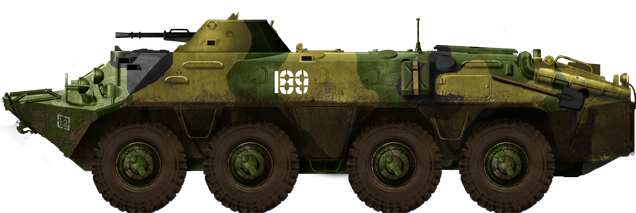
Late type, camouflaged, unknown mot. rifle regiment unit.

East German SPZ-70, late 1980s
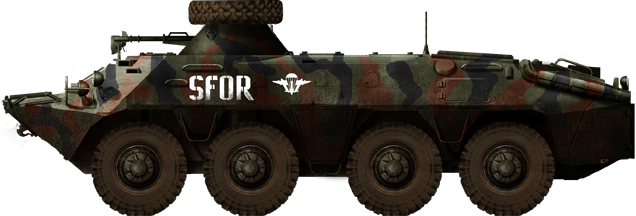
Mid-production type, Ukrainian peackeeping forces in the Balkans, Sarajevo 1995.

Late type, Ukrainian VDV 240 special batallion in peacekeeping operations, Balkans 1995-97.
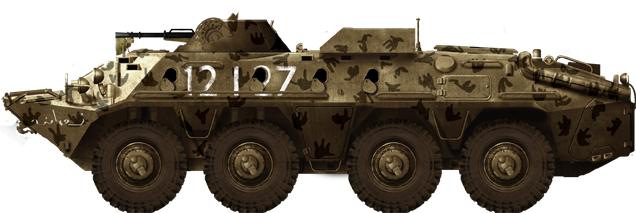
Romanian TAB-77 in Afghanistan, 2007.
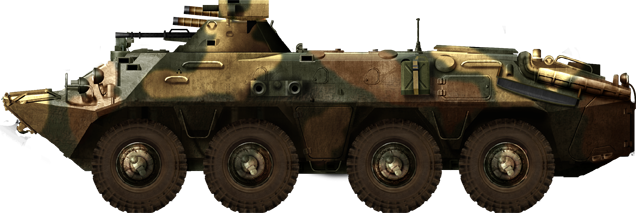
BTR-70D-1 Cobra K, modernized version in Russian service, 1990s.
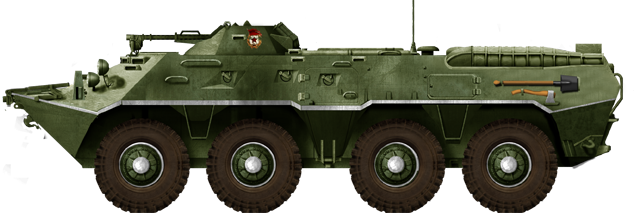
BTR-80, early production, in the Moscow May 1987 parade.

Russian BTR-80, early type
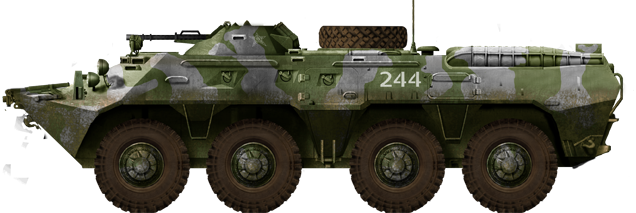
BTR-80 in Afghanistan, 1988-1989
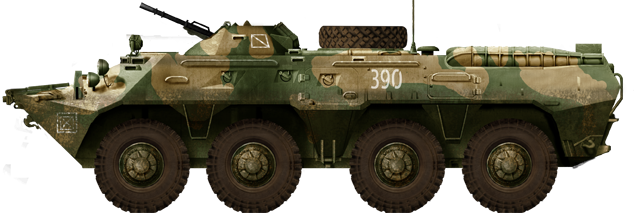
BTR-80 in Afghanistan
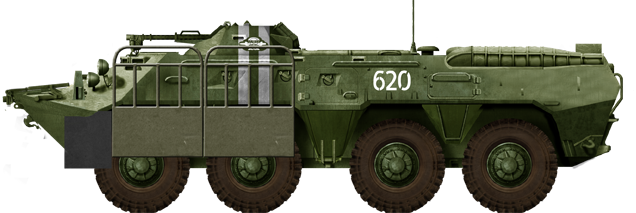
Ukrainian BTR-80 in Novorussia, Crimean conflict 2014
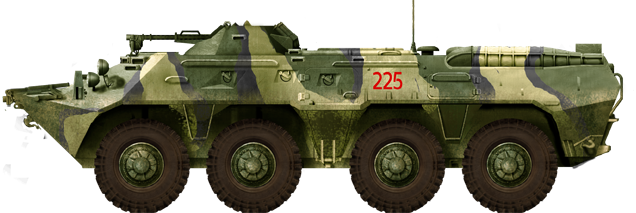
BTR-80, Naval Infantry
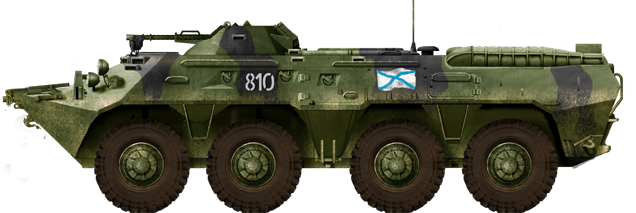
BTR-80, Naval Infantry

BTR-80, IFOR batallion, Balkans

Russian Bataillon KFOR
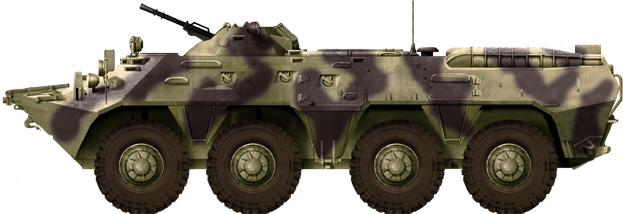
BTR-80 of the Ukrainian army in Iraq, Al Kut to As Suwayrah patrol area, Operation IRAQI FREEDOM
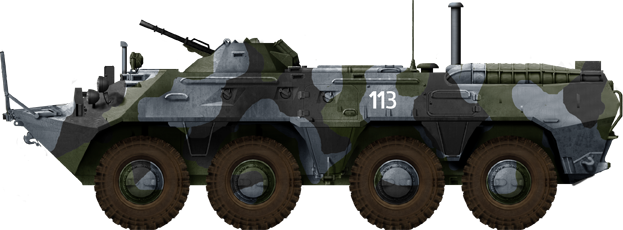
BTR-80 of the Ukrainian Marines
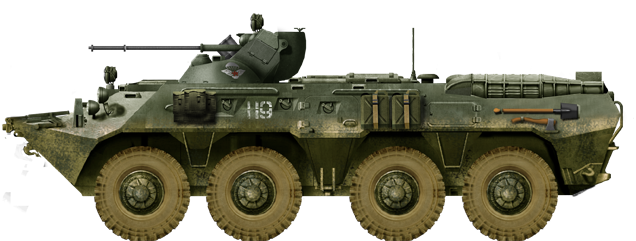
Russian BTR-80A
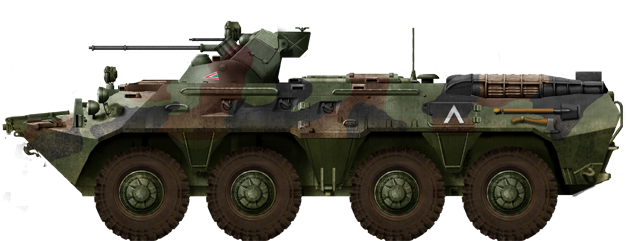
BTR-80A, Hungarian KFOR Batallion, Bosnia
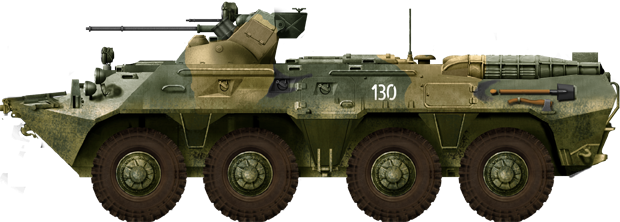
Russian BTR-80A as of today
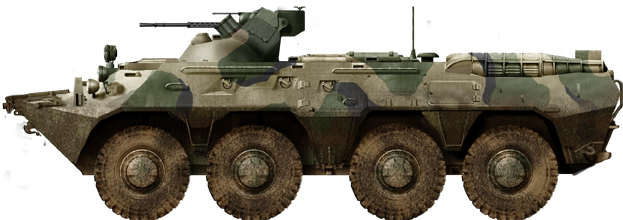
Russian BTR-82
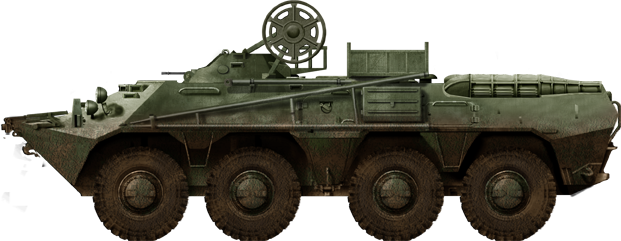
BREM-K armoured recovery vehicle
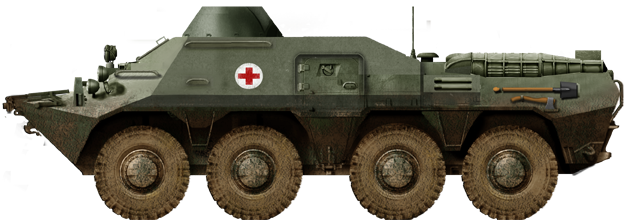
BMM-80 “Simfoniya” armoured ambulance
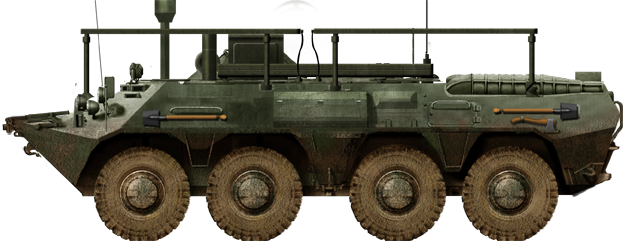
RKhM-4-01 advanced NBC reconnaissance vehicle
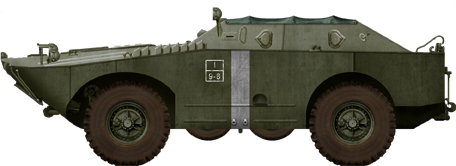
BRDM Obr.1957 or BTR-40P. This vehicle had an open roof.

BRDM Obr.1958 in parade livery. Enclosed roof but still unarmed.
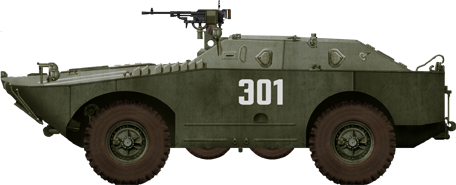
BRDM Obr.1959, the standard production version.
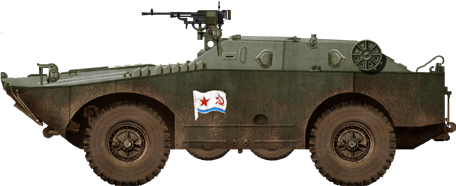
BRDM Obr.1960 of the Marines. Secondary pintle-mounted SMGB medium MGs
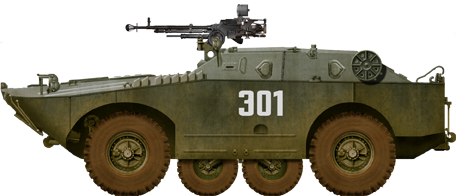
Mid-production in the 1960s, armed with a 12.7 mm DShK
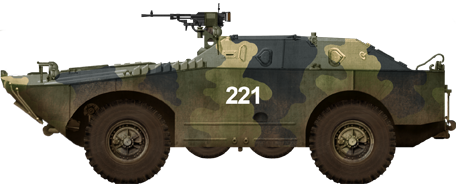
Camouflaged BRDM-1 in the 1970s
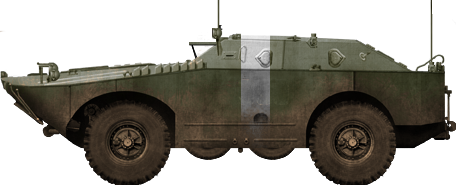
BRDM-1U (Command Car) in the 1970s
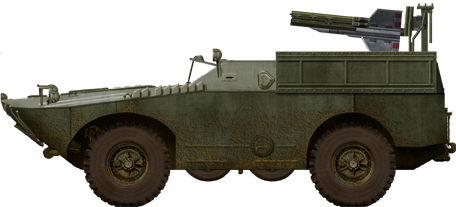
2P27 Tank Destroyer (1958) armed with AT-1 Snapper ATGMs
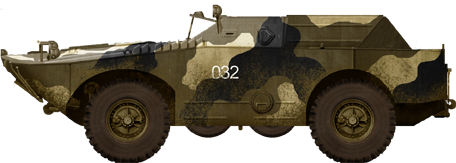
9P110 Tank Destroyer (1963) armed with the Malyutka (AT-3 Sagger)
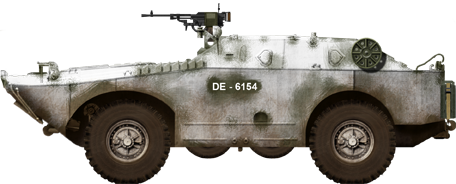
Polish BRDM-1 in winter paint.
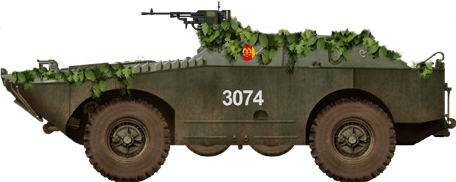
East German SPW-40P.
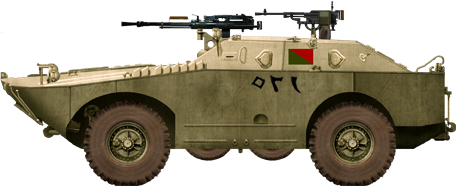
Egyptian BRDM-1, 12th Intantry Brigade, 6th Armoured Regiment, 288th Arm. Batll. 2nd Co. in 1973.
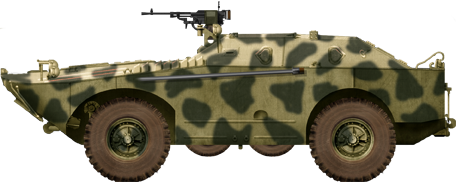
Libyan BRDM-1 in the 1990s.
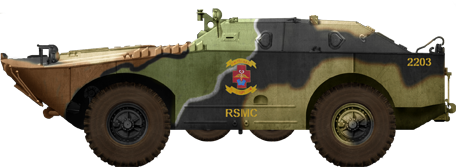
Indonesian Marines BRDM-1.
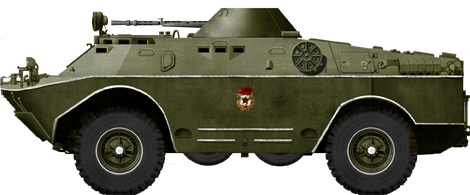
BRDM-2 of the first serie in a red square parade, 1960s

Schutzenpanzerwagen 40P2 (BRDM-2 with the East German Army), 1960s
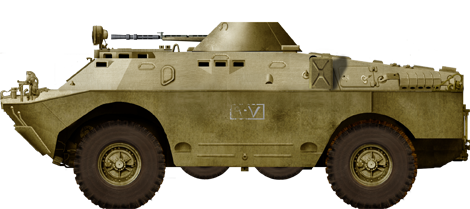
Egyptian BRDM-2, 1967 six-days war.
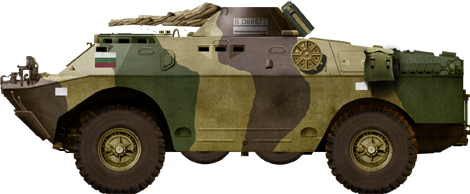
Bulgarian BRDM-2 in a modern-days joint US amphibious exercise red cloud, Aegean Islands
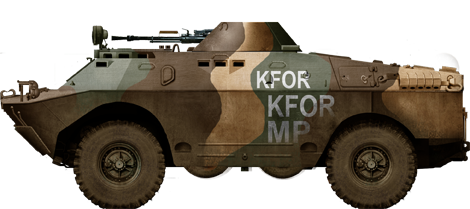
Ukrainian BRDM-2 KFOR
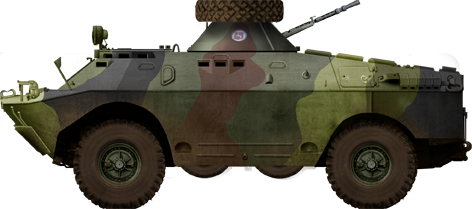
Czech BRDM-2
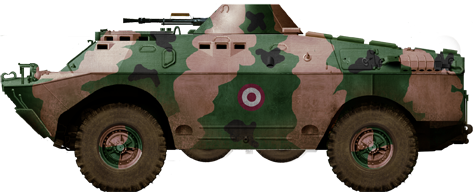
Peruvian late production BRDM-2
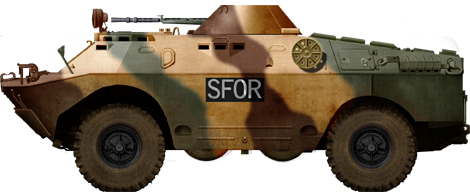
Late BRDM-2 SFOR
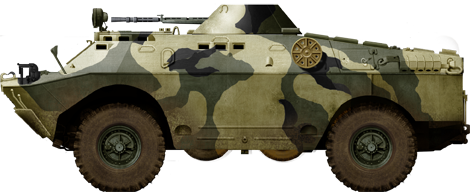
Late Russian BRDM-2
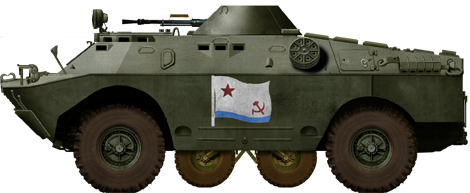
Late BRDM-2, Soviet Navy
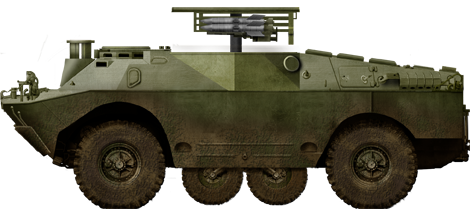
BRDM-2 9p133 Malyutka tank hunter version in Soviet Service
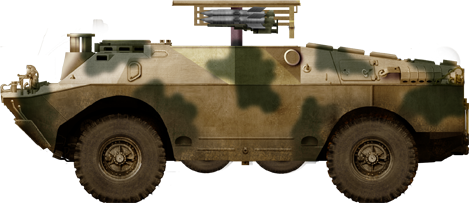
Syrian 9p133 tank hunter, 2015-2016 Civil war
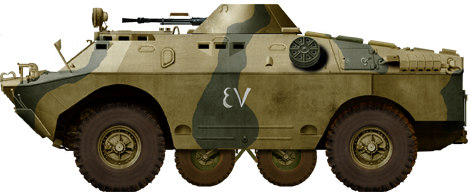
Late production Syrian BRDM-2
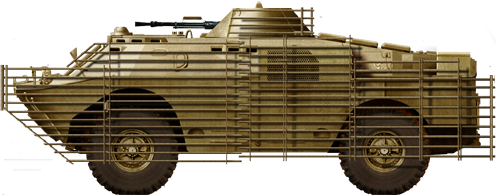
Polish Szlazak as of today.
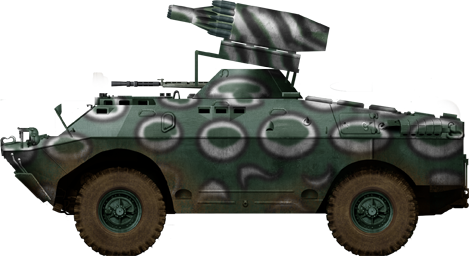
Afghan modified BRDM-2 with an aircraft-type rocket launcher mounted top of the turret
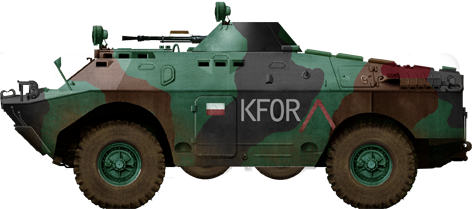
Polish BRDM-2
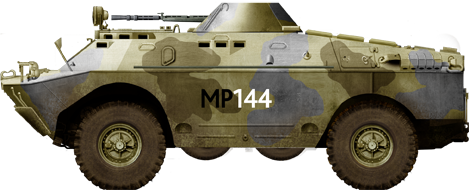
Romanian BRDM-2
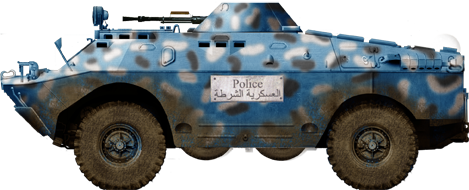
BRDM-2 of the Syrian Police, nowadays
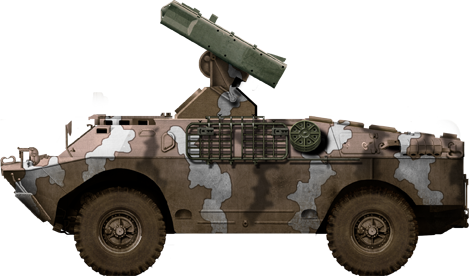
Croat 9P31 Strela-1 (SA-9 Gaskin) SAM carrier
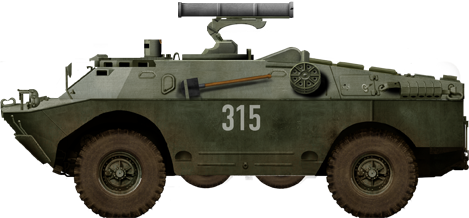
Soviet 9P148 ATGM tank hunter
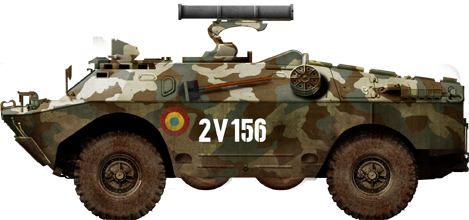
Romanian 9P148 Konkurs
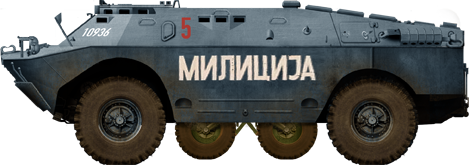
BRDM-2 of the Bosnian Militias
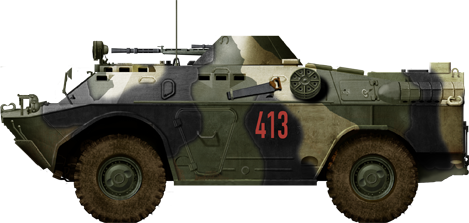
Ukrainian modernized BRDM-2.
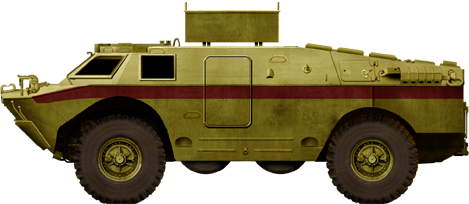
BRDM-2 in civilian service
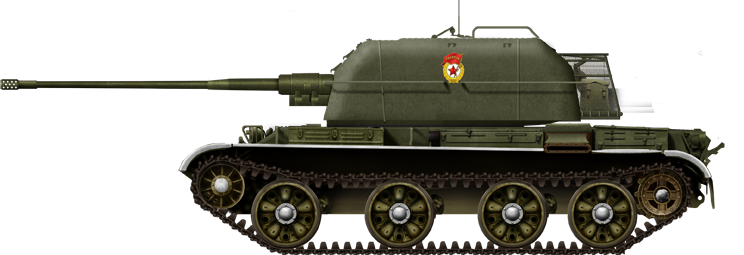
Zenitnaya Samokhodnaya Ustanovka 57-2 in red square may parade colours and markings, 1960s
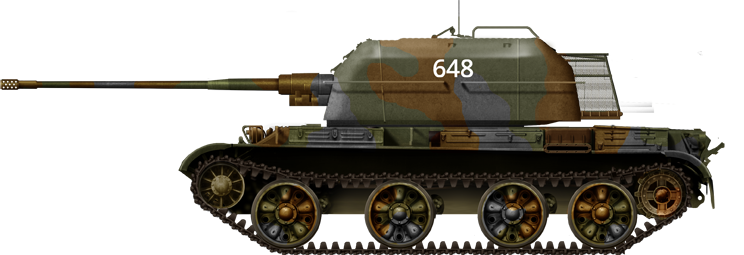
Camouflaged ZSU-57-2, 1970s. The turret rear basket was not intended to be used as storage, and was usually left empty to collect spent rounds.
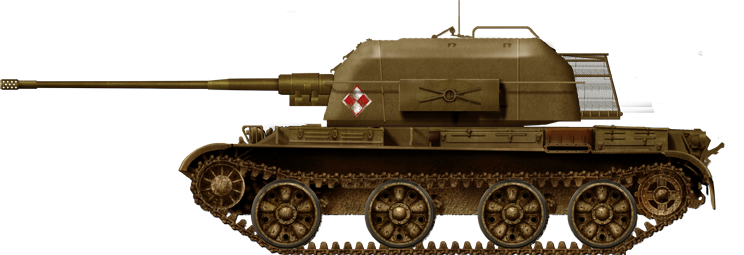
Polish ZSU-57-2, 1960s
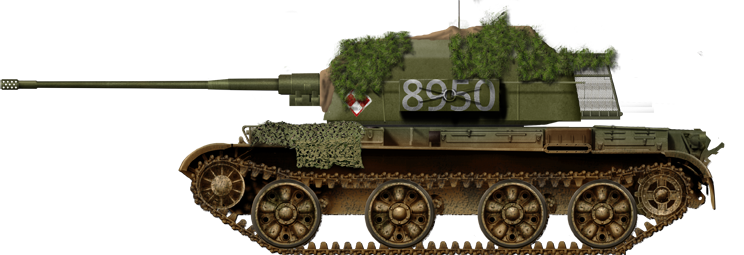
Another Polish ZSU-57-2, late 1970s
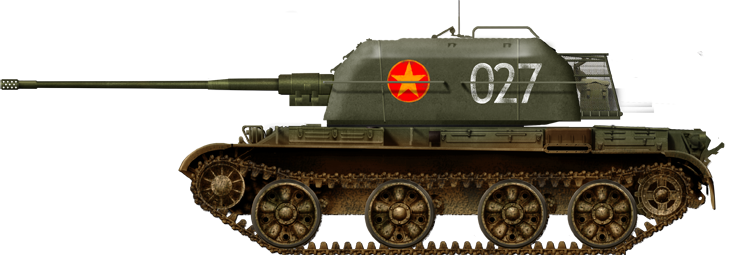
North Vietnamese ZSU-57-2. About 500 were deployed, and it was quickly discovered like the Duster, that it was just as effective in providing fire support for infantry attacks.
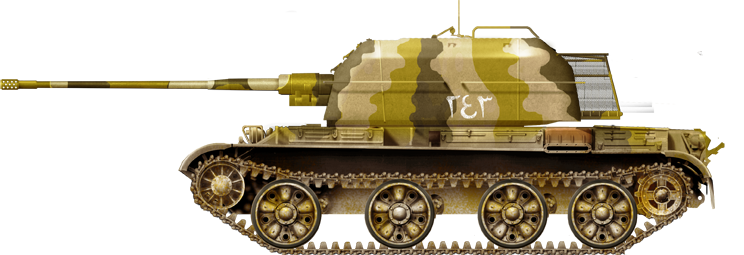
Syrian ZSU-57-2 in 1973
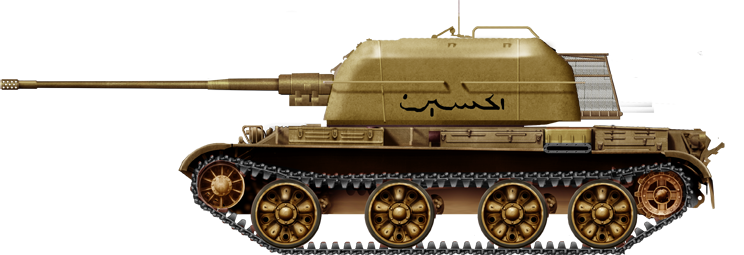
Egyptian ZSU-57-2 in 1973, Naqayeb, Debabh Air Defence Company.
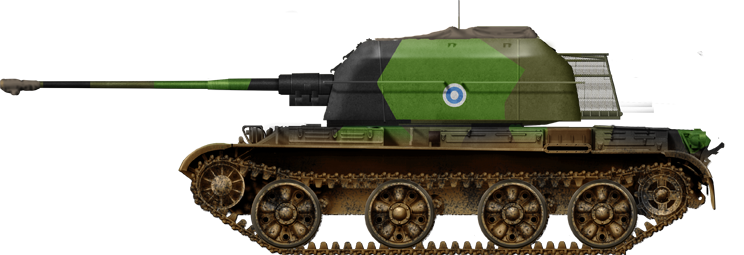
Finnish ItPsv SU-57. Some were given an additional front machine gun.
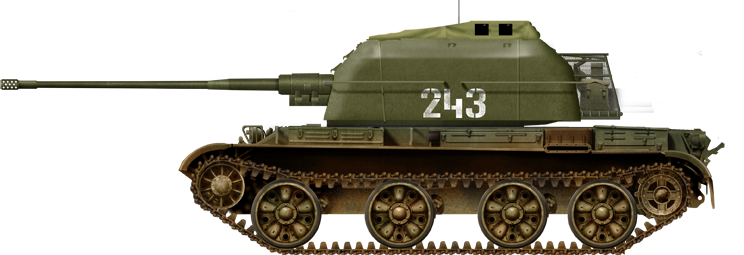
Soviet ZSU-57-2 with a canvas above the turret

Soviet 2S7 in parade colors, late 1970s.

Kazakh 2S7 as of today.

Russian 2S7 in the 1990s.
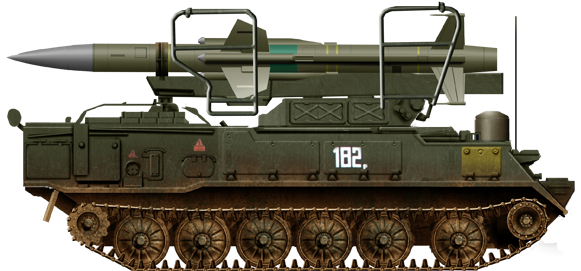
Basic 2K12 Kub
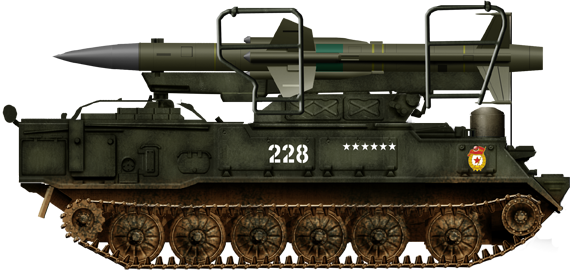
2K12 of a red guard unit in the 1970s
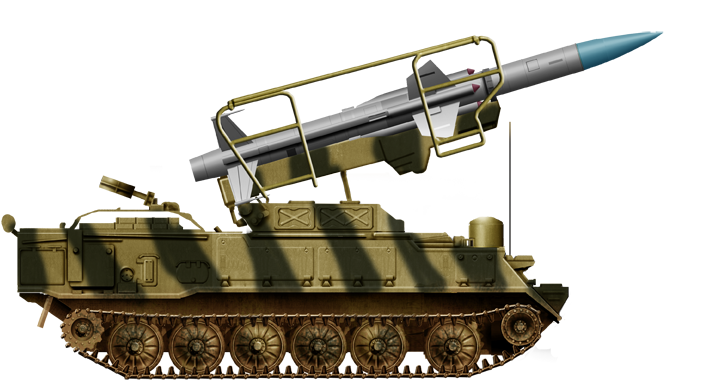
Egyptian 2K12 during the Yom Kippur war, 1973. Others were painted with the usual light olive and brown stripes over sand beige
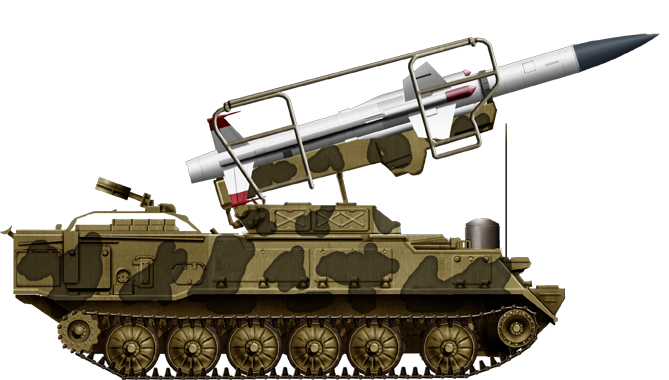
No caption available
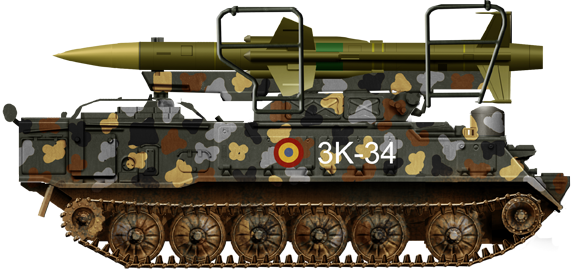
Romanian 2K12
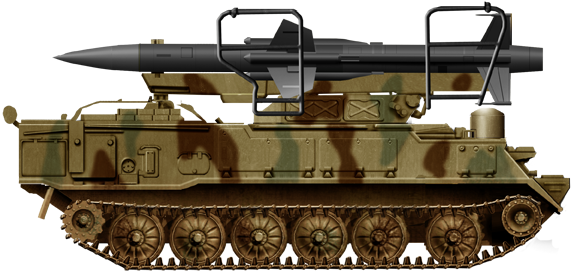
Libyan 2K12 during the UN intervention. In March 2011, Gaddafi’s forces did not managed to shoot down a single NATO plane.
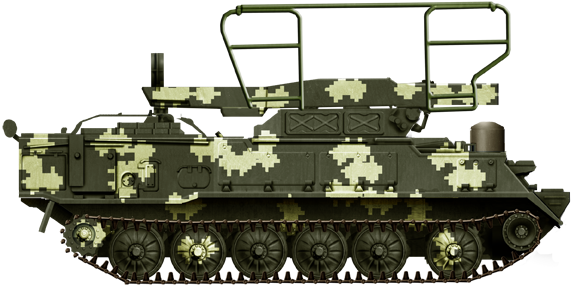
Ukrainian Kub with digital paint as of 2018

Soviet T-80, early preseries, 1970s

Soviet T-80, late 1970s

Soviet T-80 early 1980s

Soviet T-80B, 1978

Soviet T-80B, 1980s

Soviet T-80 BV, 1980s

Russian T-80BV, 1990s

Russian T-80 BV in Grozniy, 1994

T-80 BV in Transnistria, 1996

Russian T-80BV

Russian T-80BV

T-80 BVD
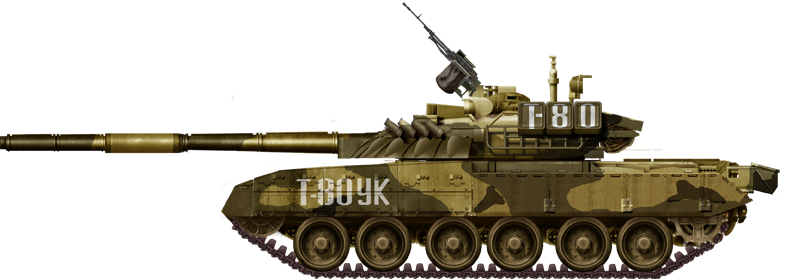
T-80 UK, official presentation prototype

Russian T-80 BU
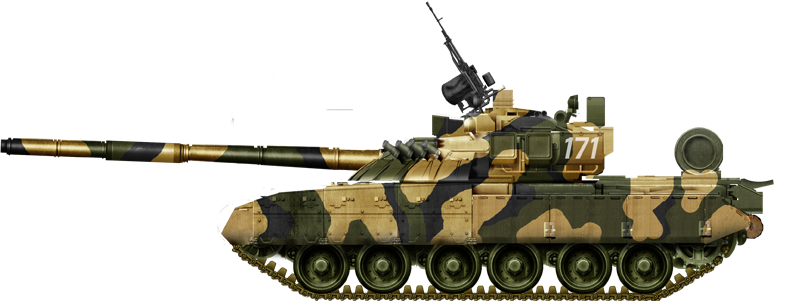
Russian T-80U Guard Kamtemirovets, Moskow, 1991

Pakistani T-80U
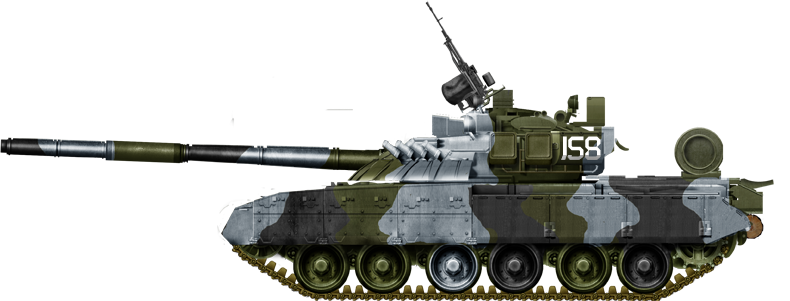
Russian T-80U, 2001

Russian T-80UK
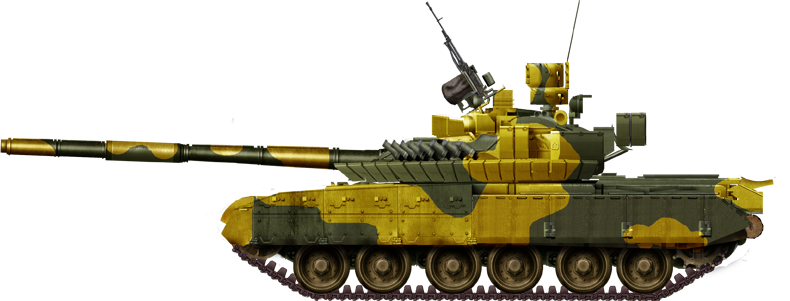
Russian T-80UM

T-44, forebear of the T-54 family, equipped with the same turret and main gun as the T-34/85.

T-54-1 early type (1948), with the transitional turret and many T-44 chassis features.

Egyptian T-54-1, war of 1967.

T-54-2, second early type (1949).

Upgraded T-54-2 of the Soviet Army, fall 1950.

Syrian T-54-2, Six-Day War, 1967.

T-54-3 (Object 137), third pre-production type (1951), with the definitive turret. Notice the spoked wheels.

T-54, early mass-production type (1951). Notice the early spoked wheels.

Soviet naval infantry T-54, 1960s.

T-54A of a Red Guards unit, 1955.

Egyptian T-54A with spoked wheels, war of 1967.

East German T-54A.

Polish-built T-54AM, recognizable by the turret extra storage bins.

Afghan T-54A, stripped of almost all its storage and mudguards, Panshir Valley, 2002.

T-54B with winter camouflage, 1958.

Polish T-54B, 1970s. Notice the mix of old spoked wheels and modern ones.

North Vietnamese T-54B during the Têt offensive in 1968. 900 are still operational today, forming the bulk of the Vietnamese force.

Egyptian T-54B with spoked wheels, war of 1967.

Egyptian T-54B in 1973, Yom Kippur war, upgraded with a new rangefinder.

Czech T-54B, 1976.

Soviet T-54B, presumably of a Red Guards unit, on display today.

Cambodian T-54B, 1980s.

Serbian T-54B, Kosovo 1992. There are unmistakably recognizable due to their improvised protection made of extra rubber panels.

Lebanese Militias T-54B, Beirut, 1980s.

The Object 430, forefather of the T-64, 1960.

The Object 432, T-64 series prototype.

T-64 of 1966-67. 600 tanks of this first series were built until 1968, plagued by teething problems.

T-64 in winter paint, winter 1967-68.

T-64A, 1968.

T-64A, winter 1970.

T-64A, mid-production, 1970.

T-64, mid-production with a tri-tone pattern, 1972.

T-64A, late production, 1977. The tri-tone autumn camouflage sand is replaced by washable white.

T-64A model 1981.

Object 437, T-64B prototype, 1975.

T-64BV, upgraded version with ERA, 1980s.

T-64BVK command version, 1980s.

T-64BV-1 export version, 1980s. The Congolese army received them in 2013.

T-64B1, 1984

T-64BM2, with the “Knife” ERA protection, 1990s

Ukrainian T-64U, 2000s. This differed by using “Kontakt-5” type ERA protection and other turret details.

Ukrainian T-64BM Bulat in parade colors, 2014. These tanks took part to the Ukrainian conflict this year
Soviet T-62 Tank – Tank Encyclopedia Support Shirt
Rumble towards victory with the glorious Soviet T-62! A portion of the proceeds from this purchase will support Tank Encyclopedia, a military history research project.

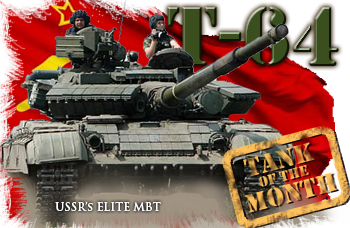

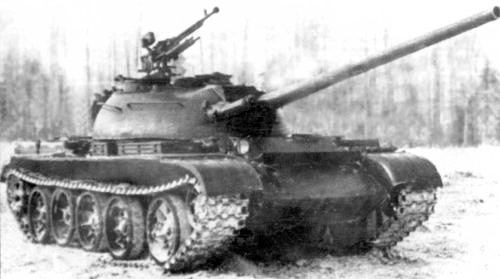


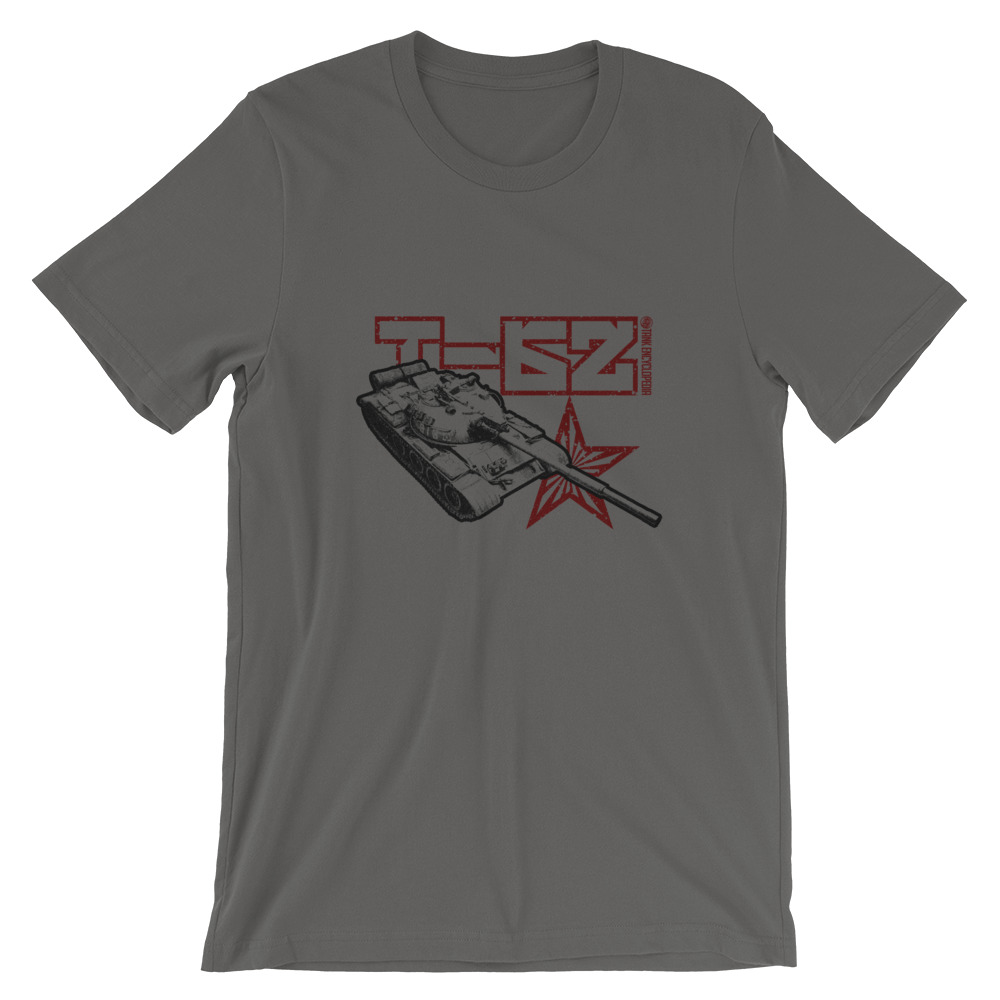
70 replies on “Union of Soviet Socialist Republics (Cold War)”
I hope to see a individual page section done for the T10/T10m
In my opinion it is a underrated tank of its time, yes it was meant to be a successor to the IS heavy tank series , and as such is arguably the last generation soviet heavy tank, however it was an extremely mobile tank for its size, it was proably comparable to the T55 in mobility.
so its a heavy tank that is good for offensives and happens to have some similarities to MBT class tanks of the time period.
which is why i think it would be interesting to see a dedicated page done or the T10/T10m tank. its proably the most unique tank of the time period.
because of this I would go as far as argue t10 was the soviet unions best tank until the development of the t64.
Hi Kevin,
There will be. It was serial-produced and it’s enough to secure its own post.
Other Soviet heavy tanks have one also as prototypes.
Cheers,
on WoT Blitz I have an IS and I say it has unbelievable firepower on the highest gun. and I would fully recommend this tank and the rest of its line to other players….
Ermm. . . WoT may not be the most realistic source to prove its power. War Thunder probably has the most realistic interpretation of the gun.
the link to the T80 is missing I hope you could end the page or fix the link “tanks”
Currently we are working on the T80. So don’t worry it will be published soon (as well as the Ukrainian T84).
All the best and stay tune !
Tbank you for your awesome website!And I really wish to see the pages of T-80,BMP-3,T-10 and ZSU-23!
Have patience Tyr, we are launching new articles every week!
Thank you again!The website is very cool And useful.
I never knew there were so many BTRs,
Try and get in contact with some 3D developers to try and make a 3d model for the ‘customers’ of this website to swivel around and look at all the out side components
Also try and get pictures of the interior for these wonderful tanks.
HeroofDover,
We’re doing this in our own private time, with no pay or other rewards. It is hobby and we are doing as much as humanly possible.
All the best,
Luke
When is the IS-6 or IS-7 ready TEAdmin
These will definitely be inn future articles.
– TE Moderator
Dear Moderators and Admin!
What else can I say, I love this site! I am a former Centurion Commander and Troop Seargent (Australian Army) and I love Tanks!!!
Keep up the great work guys, and thank you!
Brad
Thanks for the kind words!
– TE Moderator
the Korea war has been going on since 1950, but the conflict ended in 1953 not 1954.
Checked and fixed, thank you.
– TE Moderator
Can anyone help with these tanks/APC? What are these? Tanks in advance
https://postimg.org/image/p6weqce25/
https://postimg.org/image/fmvursj0j/
The first one is a ZSU-57-2. I am uncertain of the second – i’ll look further into it later on.
M19 GMC
Thank You 🙂
unless i have failed to find it, you should make an article on the zsu 23-4 shilka. nice website by the way, really informative.
There isn’t one. Yet.
Hey do y’all have plans to do object 906?
We will slowly add the various “Objects”, don’t worry.
– TE Moderator
That’s nice to hear and the reason why I asked because I saw Object 416 in the list of tanks
T-62: “An attempt to upgrade the main armament with a brand new 115mm smoothbore cannon and ***autoloader***, and a stretched-out hull.”
I’m sorry, what?
I got a Question. are you going to add the IS-7 and IS-6.
IS-7 is coming very soon. The IS-6 will come at some point in the future.
– TE Moderator
Dear moderator, let me add to the signature of the T-80 tank drawing. Indeed, this tank is based on the armies of Ukraine and the Russian Federation. But participation in battles, if he took, it is only in the Ukrainian formations (there is practically no data). From Russia militiamen, he was not supplied and on their side in the fighting was not. Please, be more objective!
Let me add to the signature of the T-10 tank drawing. This tank, with the exception of events in Czechoslovakia, took part in hostilities never.
Statistically in 1945 russia had Less than 2 million troops and less that 14,000 tanks MOST being either obsolete or light tanks because by 1944 the Wehrmacht DESTROYED OVER 99,500 of the 110,000 tanks russia had in its possession 11,860 being lend lease. FACTS
I when I clicked the link for the IS-4 under the illustration of the IS-4 it brought me to the T-34-57 could you please fix that?
Fixed, thanks for spotting it !
SU-152 “Taran” page in the works, i’d guess?
btw, when i look at it, it actually seems to look a lot like the Type 89 TD..
I’d agree that the layout and silhouette are quite similar, however the suspension and turret dimensions are quite different. Vehicles with long guns (such as self propelled artillery) tend to have a rear mounted gun to save space, if the gun was at the front it would poke into all sorts of things (ie trees) and make transport on ships or trains harder.
-TE Moderator
Maybe………
– TE Moderator
Can you do an article on the ZSU-23-4 shilka? Thanks.
Hello Sunny, like all Soviet SPAAG, it’s already in the tubes. Stay tune !
Just a question will you guys ever make a object 279 page? I know that you guys are always busy making new articles for many different tanks. Also very glad this site exist i really like learning about tanks, warplanes, and warships 😀
It may come in the future when one of our writers gathers sufficient information
-TE Moderator
good articol
His name was Iosif Stalin, hence IS series of tanks, Not JosephS damnit. Only happens in merica
When you will add the Object 279?? It’s a very and rare addition. I said that because a lot of people, maybe all, dont know the real armour or the internal components (nothing is on internet).
An article is being worked on for future publication
-TE Moderator
Nice! 🙂 If you guys are searching for info, technical schemes, cutaway, attendible armour values, exc about the Object 279 You can find these info in a important and good russian military magazine 🙂
”Техника и Вооружение 2018-1” http://www.armourbook.com/other/vtrother/109651-tehnika-i-vooruzhenie-2018-01.html
”Техника и Вооружение 2017-12” https://www.ebay.com/itm/Soviet-Experimental-Heavy-Tank-Object-279-Kotin-P-1-and-Other-Articles-TiV-/332536926210
”Техника и вооружение Отечественные бронированные машины 1945-1965”
Thank you we’ll look into these.
– TE Moderator
You are welcome 🙂 I found last sources needed in link, so your work will be less hard:
– ”Техника и вооружение Отечественные бронированные машины 1945-1965” http://www.armourbook.com/bronetechnic/bronafterwwii/101587-otechestvennye-bronirovannye-mashiny-1945-1965-chast-3-tehnika-i-vooruzhenie-2014-2016.html
– ”Отечественные Бронированные Машины ХХ век Том 3: 1946-1965” http://www.armourbook.com/bronetechnic/bronafterwwii/92968-otechestvennye-bronirovannye-mashiny-hh-vek-tom-3-1946-1965-ceyhgauz.html
I didnt found only the second source on my previously post (Техника и Вооружение 2017-12). At the moment you cant find it on internet. But i ordered it from Russia. If you need help i can help you when this book will arrive.
Will you add a MBLT any time or an I blind?
Helli Mikhail ! You’re perfectly right. The post has been started already. i’m updading this page with it. BTW i’m searching for the exact number of these produced. The usual number i see is about 2,300 but it should be higher due to the number of variants.
why the theme images is a vietnamese’s tank ? it suppose to be a ussr t 54, not a vietnam’s t54
Hello Wilson !
Quite pertinent indeed, that was in fact the only color photo of the T-54/55 in the position and angle i wanted by then. It also underline the fact these tanks were massively exported, but it will be reused in a Vietnam tank page in the future, perhaps this year. Staytune for more ! David B.
When will an article on the Tunguska be published?
Good work guys
Hello Komatsu,
While to Tunguska is definitely within our sights, we are not currently working on an article on it.
If you would like to help us accelerate our publication rhythm, please consider donating on Patreon or Paypal!
will there be a page for other prototypes like the obj907, obj268 v4, obj277, obj257, obj268 v5, obj777, obj430, obj263, obj140, obj261, or obj705?
or were all of these tanks made up by wargaming to add tanks into the game?
Hello Skiler,
While such articles are possible and within our scope, they are not currently in the works. But you can add them to our Public Suggestion List
https://docs.google.com/spreadsheets/d/1p0Ll9TITGDiF9_fdS-tv1797JBs0_-pB70ReE_kIRkE/edit#gid=1911430820
Also, in order to help us with illustrating and publishing, please do consider donating through Patreon or Paypal.
https://www.patreon.com/tankartfund
Paypal.me/tankartfund
Question ?
is there an article in the works for the 2A3 Kondensator P2 Self Propelled Gun, if i am correct it’s a Heavily Modified T-10M Chassis with a 406mm gun that was developed as a response to the US M68 Atomic Cannon.
Thanks Mike
Not as i know of. But this impressive SPG already has an illustration since a while. Other impressive ones are on the works as we speak.
– David B, Tank Encyclopedia funder
Hello Mick,
While such an article is within our sights and within our scope, it is not currently in the works. You can add them to our Public Suggestion List and you can help by adding more sources (or other suggested articles)
https://docs.google.com/spreadsheets/d/1p0Ll9TITGDiF9_fdS-tv1797JBs0_-pB70ReE_kIRkE/edit#gid=1911430820
Also, in order to help us with illustrating and publishing, please do consider donating through Patreon or Paypal.
https://www.patreon.com/tankartfund
Paypal.me/tankartfund
“The Red Army fielded an impressive array of tanks, perhaps 50,000 surviving T-34s of all types and several thousands of IS-1, 2, 3, among other armored vehicles that were partly sent back from Mandchuria.”
Hi!, to the writer I have spotted a problem here in this part I think you meant Manchuria instead of Mandchuria in the article for in 1945 after the war.
Thanks for the amazing site. I always come here when I have questions of armored warfare. I study it and know quite a bit but your site has taught me a lot.
Hi, I would like to help with the future articles of object 279 with these links. I hope they will be useful
https://www.globalsecurity.org/military/world/russia/object-279.htm
https://web.archive.org/web/20100113022310/http://www.meshwar.vistcom.ru/tech/ob279.htm
https://web.archive.org/web/20110205002752/http://www.popmech.ru/blogs/post/377-kak-vyimirali-dinozavryi-poslednie-tyazhelyie-tanki-chast-5-1
https://forum.warthunder.com/index.php?/topic/411135-opinion-for-object-279/page/2/
This is the place for them. The file is free to edit.
https://docs.google.com/spreadsheets/d/1p0Ll9TITGDiF9_fdS-tv1797JBs0_-pB70ReE_kIRkE/edit#gid=1911430820
Will their ever be an article on the 2K22 Tunguska?
Hello,
While such articles are within our sights and within our scope, they are not currently in the works. You can add them to our Public Suggestion List and you can help by adding more sources (or other suggested articles)
https://docs.google.com/spreadsheets/d/1p0Ll9TITGDiF9_fdS-tv1797JBs0_-pB70ReE_kIRkE/edit#gid=1911430820
Also, in order to help us with illustrating and publishing, please do consider donating through Patreon or Paypal.
https://www.patreon.com/tankartfund
Hi ! Strange that you do not have these tanks in the encyclopedia, which are even made in metal Object 279 and IT- 1 !
https://en.topwar.ru/7659-obekt-279.html
http://otvaga2004.ru/tanki/istoriya-sozdaniya/drakon-3/
> At that point in early 1946, a fight would have been a long and protracted one, since on both sides soldiers and crews were well equipped quite experienced.
While a war would certainly be protracted, the claim it would be protracted because “both” sides soldiers and crews were “well-equipped and quite experienced” is completely contradicted by the actual US Army, both at the time and in historical documentation. Under the points system, the most experienced American personnel were actually the first to be demobilized. As a result, “the decline of combat effectiveness was not in proportion to the reduction in total strength. Rather, it diminished at a progressively faster rate than the
members of military personnel decreased. By the Fall and Winter
of 1945-1946 the armies and the air forces that had been victorious in Europe and in the Pacific were no longer a closely integrated military machine, but rather had disintegrated to little more than large groups of individual replacements.” (Page 266)
In fact, as early as November 1945, “The European Commander further estimated that in an offensive his troops, ground (including service) and air ‘could operate in an emergency for a limited period at something less than 50 % normal wartime efficiency.’ European ground troops could operate somewhat better in a defensive situation but this was not true of air units. General Eisenhower’s Chief of Staff was reported as having said that ‘This estimate is frankly optimistic, based on assumptions themself optimistic, and does not consider morale and
fighting spirit, which he . . . [believed to be] lacking.'” (Page 266)
Discussing the impact of demobilization on the air forces, Maj. Gen. St. Clair Streett – Deputy Command of the Continental Air Forces – noted
Quotes sourced from “History of Personnel Demobilization in the United States Army”. https://history.army.mil/html/books/104/104-8/CMH_Pub_104-8.pdf
By contrast, the Soviets retained their most experienced and healthy personnel, releasing the oldest, less experienced, and more infirm first.
The main thing that would make a war protracted has little to do with the relative starting experience and equipment at the start (as both were MASSIVELY in the Soviets favor) and everything to do with the same geographic features that protected Britain and America from Germany: the ocean. The Soviets lacked the naval power to effectively support amphibious attacks. The West’s superior naval power would allow them to rebuild their armed forces and attempt to re-enter the continent at a later date, presumably after the Soviets had been softened up by strategic atomic bombardment.
The statement that the purpose of the openly genocidal Morgenthau Plan was “rearming Germany” is so ludicrous I hope it is some kind of typographical error.